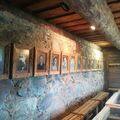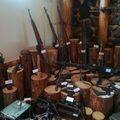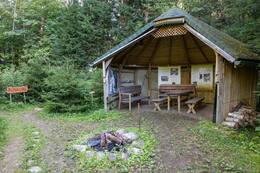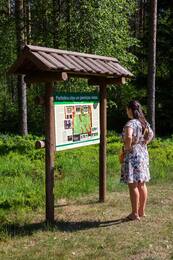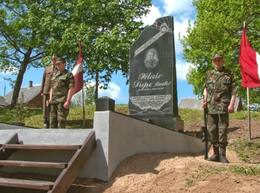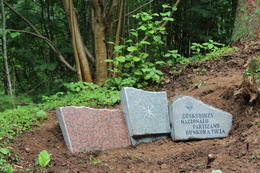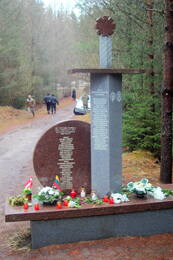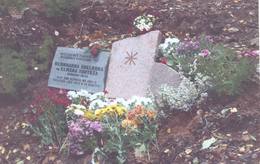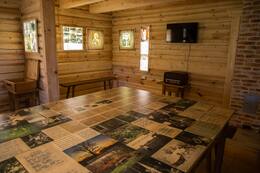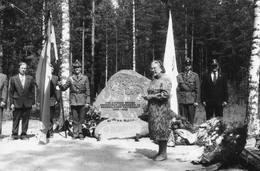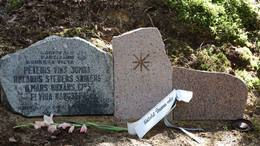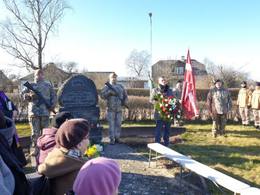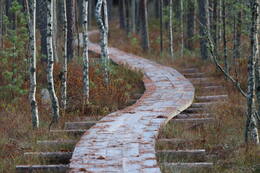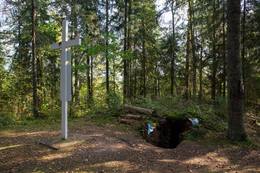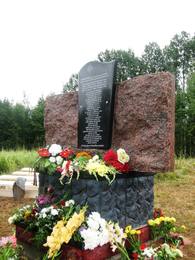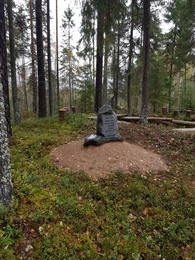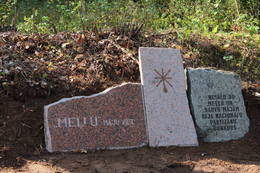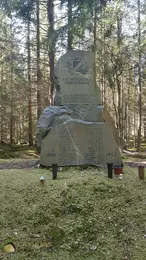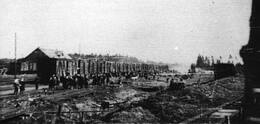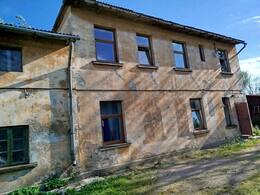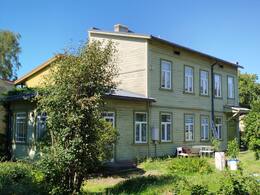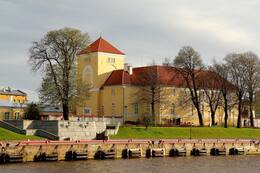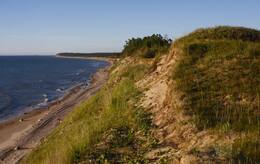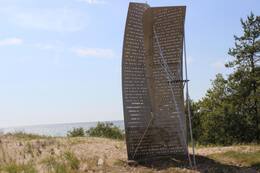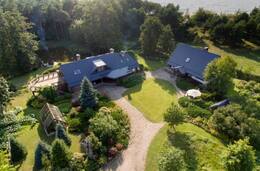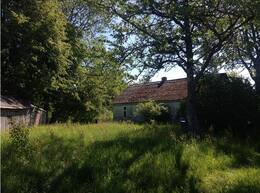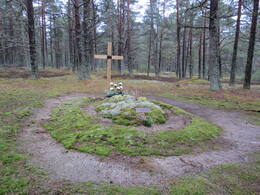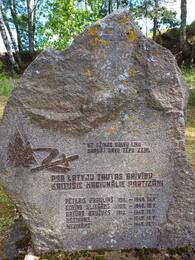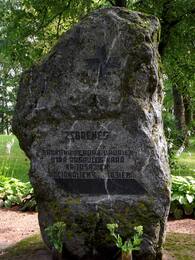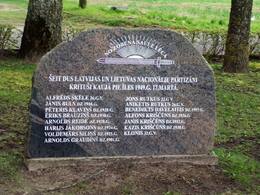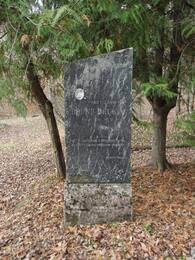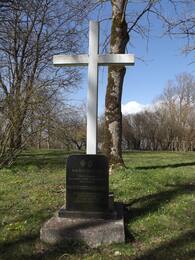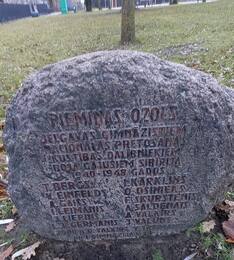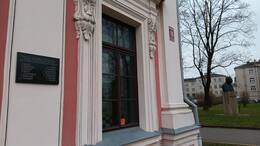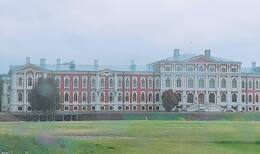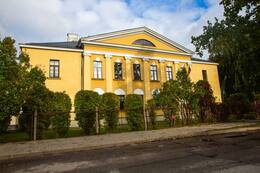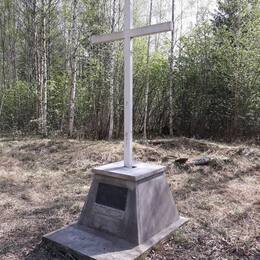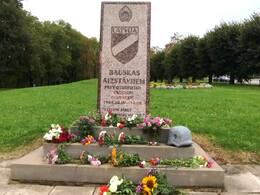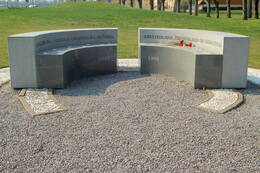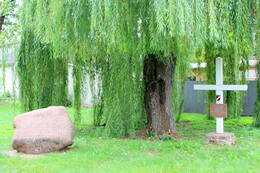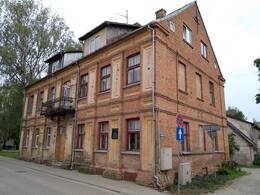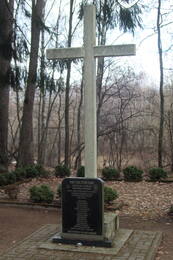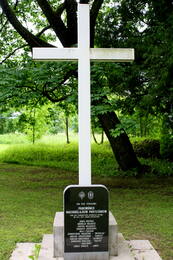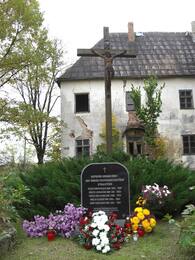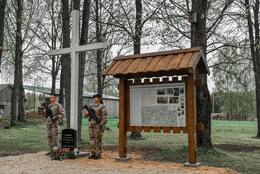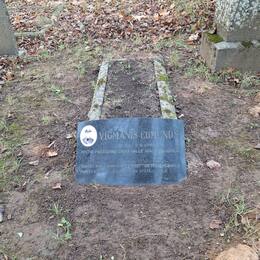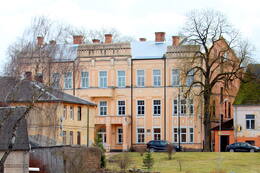Nacionalinis pasipriešinimo judėjimas
II Antrasis pasaulinis karas, IV Sovietų okupacija, III Nacionaliniai partizanai
Latvijos Respublikos žmonių veiksmai siekiant atkurti 1918 m. lapkričio 18 d. paskelbtą Latvijos valstybę.
Nacionalinis pasipriešinimo judėjimas pasireiškė kaip ginkluota kova prieš vieną ar abu okupacinius režimus, įskaitant paramą ginkluotai kovai teikiant materialinę ir kitokio pobūdžio pagalbą, taip pat Latvijos Respublikos nepriklausomybės idėjos propagandos skleidimą ir atvirą pasipriešinimą okupacinių režimų tvarkai ir ideologijai.
Susijusi laiko juosta
Susijusios vietos
Rendos nacionalinio pasipriešinimo judėjimo muziejus
Muziejus yra įsikūręs už kelių kilometrų nuo Rendos parapijos centro. Parodoje pasakojama apie 50 metų trukusį pasipriešinimo judėjimą Latvijoje: pasipriešinimą pirmajai sovietų okupacijai, pasipriešinimą nacistinės Vokietijos okupacijai ir ginkluotą bei nesmurtinį pasipriešinimą sovietų okupacijai. Paroda įsikūrusi dviejuose pastatuose. Pirmajame pastate saugomi pirmosios sovietų ir vokiečių okupacijos įrodymai. Parodoje eksponuojamas restauruotas tvarto pastatas, kuriame dėmesys sutelktas į Nacionalinį partizaninį karą. Tarp dviejų pastatų yra autentiško išplanavimo bunkeris ir kareivių naudoti apkasai. Netoli muziejaus Rendoje esantys kasinėjimai, blindažo aikštelė ir kliūčių ruožas tarnauja kaip jaunimo sargybinių ir visų susidomėjusiųjų treniruočių aikštelė. Apsilankymus būtina užsisakyti iš anksto.
Vienas didžiausių nacionalinių partizanų mūšių, vadinamas Āpūzniekų mūšiu, įvyko 1946 m. sausį netoli čia. Mūšyje Kabilės nacionalinis partizanų būrys nugalėjo daug didesnes okupacinės valdžios pajėgas. Mūšio vietoje, kurioje yra informaciniai stendai, dabar įrengta poilsio aikštelė.
Nacionalinių partizanų bunkeris – Miško broliai
Miško brolių bunkeris yra prie Rygos–Pskovo (A2) greitkelio, 76 kilometrus nuo Rygos ir 11 kilometrų nuo Cėsių. Latvijos nacionaliniai partizanai arba miško broliai buvo nedidelės, ginkluotos vietos gyventojų grupuotės, kurios nuo 1944 iki 1956 metų Latvijos teritorijoje kovojo savarankiškai prieš SSRS okupacinį režimą. Miškuose buvo priversti slėptis žmonės, kurie negalėjo arba nenorėjo gyventi Sovietų Sąjungoje. Iš viso Latvijoje veikė apie 20 193 miško broliai. Bunkeris buvo suformuotas remiantis buvusių miško brolių pasakojimais ir prisiminimais apie gyvenimą miškuose, slapstymąsi ir kovą už nepriklausomą Latvijos valstybę po 1945 metų. Bunkeryje eksponuojami ginkluotė ir namų apyvokos daiktai. Eksponuojami partizanų asmeniniai daiktai, ginklai ir nuotraukos. Gido pasakojimą papildo vaizdo įrašas iš interviu su miško broliais. Prie bunkerio yra vieta piknikui. Galima iš anksto užsisakyti ant laužo paruoštos sriubos arba mėgautis vakaru po atviru dangumi žiūrimu kino teatru prie laužo.
Gryvos miške vykusios nacionalinės ir sovietinės partizanų kovos ir atminimo vietos
Įsikūręs Gryvos miškų masyve.
Galima apžiūrėti šešis objektus, susijusius su nacionalinių ir sovietinių partizaninių kovų vietomis.
Gryvos miško masyve yra ne tik „Purvsalinių“ nacionalinių partizanų štabas, Baltasis kryžius nacionalinių partizanų bunkeryje ir kryžius pasipriešinimo judėjimo vadui Andrejui Roskošui, bet ir sovietinės partizanų brigados vado Artūro Baložo kapas, paminklas vadinamojoje Meitenių kalninėje, kur 1944 m. žuvo grupė jaunų sovietinės partizanų brigados partizanų, taip pat sovietinių partizanų paminklas su penkiakampe žvaigžde ir išgraviruotais žodžiais „Mes apsigaubėme savo adatomis“.
Objektus taip pat galima apžiūrėti važiuojant dviračiu 785 dviračių maršrutu „Istoriniai eilėraščiai Gryvos miškuose“ (maršruto ilgis 34 km, žvyrkeliai ir miško keliai). Žemėlapį galima atsisiųsti.
Nacionalinio partizanų būrio vado Andrejaus Roskošo atminimo paminklas (GPS 56.87399, 27.43524)
1997 m. rudenį Lielgryvos miške buvo atidengtas Baltasis kryžius nacionalinių partizanų grupės vadui Andrejui Roskošui.
Paminklas Artūrui Balodiui (GPS 56.872926, 27.478121)
Artūras Balodis buvo sovietų partizanas, A dalinio, dislokuoto Gryvos miško masyve, specialiųjų operacijų vadas. Jis žuvo per didelio masto „šukavimą“, kurį vykdė nacistinės Vokietijos okupantai. Jo bendražygiai žuvimo vietoje berže išraižė raides AB, kad jis nepamirštų. Po karo vietos istorikai rado pažymėtą beržą ir jo vietoje įrengė atminimo lentą.
Visiems žuvusiems Gryvos miškuose (GPS 56.863280, 27.47975)
Šį atminimo akmenį Gryvos miško masyve įrengė valstybės įmonė „Latvijas valsts meži“ pagerbiant partizanus, kovojusius už savo tėvynę. Šalia atminimo akmens yra žemėlapis-schema su partizanų štabų – lankytinų objektų nuorodomis. Taip pat įrengta poilsio zona. Netoliese yra nacionalinių partizanų gyvenvietės vieta, 1945–1947 m.
Nacionalinių partizanų gyvenvietė (GPS 56.863456, 27.481148)
Šioje vietoje buvo įsikūrusios nacionalinių partizanų, kovojusių su sovietų okupacija, gyvenvietės. Išliko atskirų bunkerių vietos, iš kurių vizualinės išvaizdos galima spręsti, kokio dydžio ir kokios formos buvo apkasai. Gryvos miškuose dar keletą metų po Antrojo pasaulinio karo veikė nacionaliniai partizanai, priešinęsi sovietų valdžiai.
Mergaičių kalnelis (GPS 56.858187, 27.521526)
1944 m. birželį nacistinės Vokietijos okupantai surengė didelio masto Gryvos miškų „šukavimą“, siekdami sunaikinti partizanus. Kareiviai apsupo Numernės kalno ūkio įmonę, kurią daugiausia sudarė jaunos merginos, ir visos buvo sušaudytos. Po šių tragiškų įvykių vietos gyventojai Numernės kalną pervadino Meitenių kalnu. Šioje vietoje pastatytas atminimo akmuo.
Paminklas Šiaurės Rytų nacionalinių partizanų vadui Pēteriui Supei – „Cinītis“
Pagerbiant nacionalinių partizanų vado Pēterio Supės atminimą, 2005 m. gegužės 28 d. Viliake buvo atidengtas jam skirtas paminklas. Jis stovi netoli Viliakos katalikų bažnyčios, karo metu iškastų apkasų pakraštyje, kur čekistai laidojo sušaudytus nacionalinius partizanus. Po P. Supės paminklu įdėta kapsulė su 386 žuvusių nacionalinių partizanų vardais, mūšių aprašymais ir medžiaga apie partizanų vadą. Akmenyje iškalti žodžiai: „Tau, Latvija, likau ištikimas iki paskutinio atodūsio“.
Paminklą suprojektavo Pēteris Kravalis.
Netoliese yra memorialas Latvijos laisvės kovotojams, žuvusiems Stompaku miške ir kitose mūšių vietose bei nužudytiems čekistų 1944–1956 m.
2008 m. birželio 20 d. dešinėje sienoje buvo atidengta granito lenta su trimis stulpeliais išdėstytais 55 žuvusių partizanų vardais.
Paminklas pastatytas toje vietoje, kur komunistinė okupacinė valdžia kadaise eksponavo nužudytų partizanų palaikus, siekdama įbauginti likusius gyventojus.
Ant greta esančios lentelės išgraviruoti padėkos žodžiai Pēteriui Supei ir Bronislavos Martuževos eilėraštis:
"Kelkis, Piteri Supe,
Siela, kovok kare!
Šiandien tavo kraujo auka,
Iškilo tarp žmonių.
Išeik ir gyvenk amžinai
Jaunystės stiprybėje ir energingoje
Jis plasnoja, plasnoja, plasnoja
"Kylančioje vėliavoje!"
Nacionalinių partizanų atminimo vieta Sērmūkšyje
Sērmūkšuose yra vienas iš daugiau nei šimto partizanų kovų memorialų Latvijoje. Latvijoje yra daugiau nei šeši šimtai partizanų kovų vietų. Remiantis istoriniais įrodymais pastatytas Latvijos nacionalinių partizanų žeminė, kurioje lankytojai gali praleisti naktį beveik autentiškomis sąlygomis su medinėmis lovomis, apšvietimu žibalinėmis lempomis ir šildymo prietaisu, panašiu į tuos, kuriuos naudojo partizanai. Apsilankymą būtina užsisakyti iš anksto. Lemtinga akimirka Sērmūkšų nacionalinių partizanų grupei atėjo 1946 m. lapkričio 29 d., kai žuvo keturi grupės kovotojai: Janis Zīrāks, Reinholds Pētersons, Janis Pīlands ir Anna Zariņa. Alfrēdsas Suipe išgyveno, atlaikė tremtį, grįžo į Latviją ir sulaukė laisvos valstybės atkūrimo. Jis inicijavo idėją Sērmūkšuose įsteigti memorialinę vietą savo žuvusiems bendražygiams.
Alsvikių parapijos nacionaliniams partizanams skirtas atminimo akmuo „Čūskubirzyje“
Įsikūręs „Čūskubirž“, Alsvikių valsčiuje, Alūksnės savivaldybėje.
Atminimo akmuo atidengtas 2018 m. rugpjūčio 21 d. Akmenkalis Ainārs Zelčs.
Čia, miško masyve, išlikusi bunkerio vieta, kur 1947 m. birželį Latvijos nacionalinių partizanų asociacijos Generalinio štabo ryšių skyriaus viršininkas Antonas Circanas atvyko į susitikimą su Bruno Bukalderso vadovaujamais partizanų atstovais, siekdamas organizuoti ir palaikyti ryšius tarp atskirų nacionalinių partizanų grupių. Antono Circano tikslas nebuvo įgyvendintas, nes jis žuvo 1947 m. liepos 7 d. netoli Drustų.
Ylės nacionalinių partizanų bunkeris
Bunkeris yra Zebrenės seniūnijoje, Ylės girininkijoje, išsukus iš kelio P104 Bikstai–Aucė.
Ylės nacionalinių partizanų grupė, kuriai vadovavo Karlis Krauja, susikūrė 1947 m. Grupės vadu buvo išrinktas V. Ž. Brizga (slapyvardis K. Krauja). 1948 m. spalį ši grupė susijungė su lietuvių nacionalinių partizanų grupe. Kraujos grupė veikė Jelgavos apskrityje, joje buvo 27 nacionaliniai partizanai. 1948 m. spalį Jelgavos apskrities Lielaucės valsčiuje, netoli Ylės girininkijos, 300 m į šiaurę nuo sodybos „Priedaiši“, Kraujos grupė įsirengė požeminį bunkerį. Jo bendras ilgis, įskaitant slaptus priėjimus, buvo 45 metrai. Aplink bunkerį buvo išdėliota 70 nuotoliniu būdu valdomų minų. Bunkeryje buvo įrengta krosnis, šulinys, tualetas ir sandėlis.
1949 m. kovo 17 d. bunkeryje buvę 24 partizanai stojo į savo paskutinį mūšį su 760 Valstybės saugumo ministerijos (čekistų) karių. Po mūšio 9 partizanai buvo suimti, o 15 žuvo, iš jų – 8 latviai ir 7 lietuviai.
1992 m. krašto apsaugos kariai kartu su Dauguvos vanagais atkūrė susprogdintą bunkerį. Toje vietoje pastatytas Baltasis kryžius, paminklinis akmuo ir granito stela.
Bunkerio viduje yra krosnelė, stalas ir siauri gultai, ant kurių miegojo partizanai. Prie bunkerio yra informacijos stendai, paminkliniai akmenys su partizanų vardais ir pavardėmis.
Atminimo lenta Veclaicenės nacionaliniams partizanams bunkerio vietoje
Įsikūręs Veclaicenės valsčiuje, Alūksnės rajone.
Atidaryta 2019 m. spalio 4 d. Akmenkalis Ainārs Zelčs.
1953 m. kovo 13 d. Veclaicenės miškuose, netoli „Korulių“ namų, čekistai aptiko kruopščiai užmaskuotą bunkerį ir suėmė Bernhardą Ābelkoką ir Elmārą Tortūzą.
Bunkeryje buvo rasti ginklai: 2 vokiški šautuvai ir 95 šoviniai, 2 „Parabellum“ pistoletai ir 152 šoviniai.
1949 m. lapkričio 11 d. Čekos agentai sušaudė K. Dokti-Dokteniekus, o jo grupuotė iširo. Po išpuolio B. Ābelkoksas ir E. Tortūzis kurį laiką slapstėsi bunkeryje netoli „Maskalių“ namų, tačiau nuo 1951 m. pavasario, padedami Ilonos Ābolkalnos, įsikūrė bunkerį „Koruliuose“, kur gyveno iki suėmimo.
Bronislavos Martuževos poezijos klėtelė
Bronislavos Martuževos muziejus įsikūręs poetės vaikystės namų vietoje Indranų valsčiuje, Maduonos savivaldybėje. Muziejaus ekspozicija įrengta renovuotame tvarte, kuriame eksponuojami balso ir vaizdo įrašai iš Nacionalinio pasipriešinimo judėjimo, poetės darbo leidžiant pogrindinį žurnalą, taip pat kuriant eilėraščius ir dainas nacionaliniams partizanams. Bronislava Martuževa dalyvavo pasipriešinimo judėjime nuo pat jo įkūrimo. Lazdinės, Martuževos namai, kurie neišliko, taip pat buvo prieglobstis Latvijos nacionalinių partizanų asociacijos vadovui Pēteriui Supei ir jo bendražygiams. Poetė penkerius metus slapstėsi savo namų rūsyje, susitikinėjo su partizanais, rašė eilėraščius (įskaitant kūrinius, skirtus partizanams Pēteriui Supei, Viliui Tomui, Smilgos grupei, Laiveniekui, Salnui, Celmiņui, Bruno Dundurui ir kitiems), taip pat rašė dainas ir mokė jų partizanus. Dabar jos dainas dainuoja grupė „Baltie lāči“ (pažodžiui: „Baltieji lokiai“). 1950 m. kartu su Viliu Tomu pogrindyje buvo leidžiamas žurnalas „Dzimtene“ (pažodžiui: „Tėvynė“). Poetas ranka perrašė 11 žurnalo numerių, po 10 egzempliorių. Poetė, jos brolis, sesuo, motina ir Vilis Tomas buvo suimti 1951 m. Bronislava Martuževa iš Sibiro grįžo 1956 m. Pripažintas vietos ir šalies mastu, poezijos tvartą lanko tiek vietos gyventojai, tiek savivaldybės svečiai. Susipažinimas su poetės gyvenimu suteikia galimybę atrasti Latvijos likimą.
Paminklas žuvusiems Latvijos legiono kariams ir nacionaliniams partizanams
Įsikūręs Lubanos naujosiose kapinėse Indrani parapijoje.
Apžiūrėti galima žuvusių Latvijos legiono karių ir nacionalinių partizanų atminimo vietą.
Memorialas atidengtas 1992 m. liepos 25 d. Atminimo akmenį sukūrė Andris Briezis.
Prasidėjus Atbudimui, 1990 m. spalį žmogaus teisių grupės „Helsinkis 86“ narys Kārlis Doropolskis gavo valdžios leidimą pradėti perlaidoti 1944 m. vasarą Lubanoje žuvusius ir palaidotus Latvijos legionierius, taip pat vėlesniuose mūšiuose su sovietų okupacine kariuomene ir saugumo institucijomis žuvusius nacionalinius partizanus bendruose masiniuose kapuose, kurie buvo įrengti naujose Lubanos kapinėse. Iš viso masiniuose kapuose buvo palaidoti 26 žuvę legionieriai ir nacionaliniai partizanai.
Nacionalinės partizanų grupės „Jumba“ bunkerio atminimo vieta
Įsikūręs Ziemerso parapijoje, Valstybinio miško 66-ajame kvartale.
Memorialas buvo atidengtas 2020 m. liepos 10 d.
Antrajame Latvijos nacionalinio partizanų judėjimo etape, 1948 m. viduryje, nuo J. Bitāno-Liepačo būrio Mālupē-Bėjos valsčių teritorijoje atsiskyrė 4 asmenų grupė - Vikas Pētersis, Steberas Rolandas, Bukanas Ilgmārs ir Kangsepa Elvīra, kurie pradėjo savarankišką veiklą Ziemeros-Jaunlaicenės-Veclaicenės valsčiuose. Partizanų štabas buvo netoli Estijos sienos, netoli Rygos-Pskovo plento, ant kalvos, gerai įrengtame bunkeryje.
1950 m. kovo 2 d., čekistams aptikus bunkerį, partizanai pasislėpė iš riedulių pastatytame tvarte „Napke“ name Estijos pusėje. Po ilgų ir įnirtingų susišaudymų 1950 m. kovo 3 d. čekistams pavyko tvartą padegti. Ilgmārs Bukāns, Rolands Stebers ir Elvīra Kangsepa sudegė kartu su naujagime dukra. Pēteris Viks iššoko pro tvarto langą ir pasislėpė namo palėpėje, kur buvo rastas ir sušaudytas. Ūkis buvo sudegintas. Visų žuvusių partizanų kūnai buvo išvežti į Alūksnę. Kovotojų žūties vietoje 1990-ųjų pradžioje buvo pastatytas atminimo ženklas. Elvyros Kangsepos dukra, gimusi degančiame tvarte, buvo vardu Liesma.
Nacionalinių partizanų memorialinė vieta Striķu gatvėje, Saldus
Memorialas yra Striķu ir Lauku gatvių sankryžoje.
Tragiškai kruvinas įvykis šioje vietoje įvyko taikos metu 1950 m. vasario 24 d. Salduse, Strikių (tuometinės 5. augusto) gatvėje, netoli 33-iojo ir 35-ojo namų. Šios gatvės 33-iajame name, po Žiemgalos miško brigadų grupės su jos štabo bunkeriu Ylės miškuose sunaikinimo 1949 m. kovo mėn., gyvi ir nesugauti trys miško brigados, tarp jų pats grupės vadas Kārlis Krauja (tikrasis vardas Visvaldis Brizga) ir jo bendrininkas Vilis Krusts. Jie tikėjosi praleisti 1950 m. žiemą Bergmanių namuose Salduse, tačiau buvo suimti ir susekė. Abu namus apgulė apie 30 čekistų, o anksti ryte įvyko įnirtingos kovos. Čekistai buvo apšaudyti iš abiejų namų, tačiau pralaimėję triuškinančiai persvarai, abu partizanai bandė pabėgti į netoliese esantį Veidės mišką. Tačiau čekistai partizaną Krustą nušovė jau ant namo laiptų, o Kraują – apie 80 metrų toliau miško link.
Abu namai buvo padegti, gyventojų iš anksto paprašius išeiti ir pažadėjus, kad jų gyvybės bus išsaugotos. Yra pranešimų, kad žmonės išėjo, bet vis tiek buvo sušaudyti vietoje. Tarp sušaudytųjų arba dūmuose uždususių žmonių buvo tėvas ir sūnus Kursinskiai iš 35-ojo namo, kurie rėmė partizanus, bet taip pat buvo sušaudyta Kursinskių namo gyventoja Leontine Ezerkalni, kuri nežinojo apie savo šeimininko ryšius su miško brigadomis.
Nacionalinių partizanų būstinė gamtos draustinyje „Stompakų pelkės“ (Stompaku purvi)
Antrojo pasaulinio karo metais Stompakų pelkėje buvo viena didžiausių nacionalinių partizanų būstinių Baltijos šalyse. Šiandien ši teritorija priklauso Stompakų gamtos draustiniui. Pelkių salose esančią gyvenvietę galima pasiekti pažymėtu pėsčiųjų taku.
1945 m. pradžioje Stompakų pelkėje buvusioje nacionalinių partizanų būstinėje gyveno 350–360 žmonių, iš jų – 40 50 moterų. Joje buvo 24 gyvenamieji bunkeriai – pusiau į žemę įkasti statiniai, kuriuose galėjo gyventi 3–8 žmonės. Būstinėje taip pat veikė kepykla, požeminė bažnyčia ir trys antžeminės pašiūrės arkliams. Partizanai rengė išpuolius prieš okupacinio režimo pareigūnus.
1945 m. kovo 2–3 d. čia vyko Stompakų mūšis – didžiausias nacionalinių partizanų susirėmimas Latvijoje. Būstinėje buvusius 350–360 partizanų puolė NKVD 143-asis šaulių pulkas ir vietinio stribų (rus. „isterbiteli“) bataliono kovotojai – iš viso 483 vyrai. Mūšis truko visą kovo 2 dieną. Kovo 3-iosios naktį partizanams pavyko ištrūkti iš būstinės ir pasitraukti į ankstesnės bazės vietą. Mūšyje žuvo 28 partizanai, o NKVD neteko 32 karių.
Šiuo metu Stompakų būstinės vietoje yra atkurti trys bunkeriai – bažnyčia, štabas ir gyvenamasis bunkeris, taip pat 21 bunkerio vieta. Įrengti informaciniai stendai apie būstinę ir mūšį. Galima užsisakyti ekskursijas su gidu.
Vesetos partizanų žeminė ir atminimo vieta „Baltasis kryžius“ (Baltais krusts)
Vesetos partizanų žeminė ir atminimo vieta „Baltasis kryžius“ yra Vesetos užliejamos pelkės teritorijoje.
Po Antrojo pasaulinio karo Vietalvoje veikė vadinamoji Parupo partizanų grupė. Jai vadovavo Richardas Parupas (1914–1946), buvęs vokiečių kariuomenės 15-osios latvių divizijos seržantas. Karo metais jis dalyvavo nacionalinių partizanų veikloje Jėkabpilio ir Maduonos apylinkėse. Per neilgą gyvavimo laikotarpį Parupo grupė surengė daugiau kaip dvidešimt ginkluotų susirėmimų su tuometės Vidaus reikalų ministerijos daliniais.
Čekistų pulkininko Kotovo ataskaitoje savo vadovybei Rygoje teigiama, kad dėl šios grupės veiklos sovietinės valdžios įsitvirtinimas Jekabpilio ir Maduonos rajonuose buvo paralyžiuotas. Parupo vadovaujami nacionaliniai partizanai surado ir sunaikino kelis tremiamųjų sąrašus, taip išgelbėdami daugelio žmonių gyvybes. Kadangi atviroje kovoje nacionalinių partizanų būrio sunaikinti nepavyko, Saugumo komitetas į jį infiltravo keturis čekistų specialiosios grupės narius. 1946 m. liepos 2 d. naktį šie agentai nušovė dešimt būrio partizanų, tarp jų ir Richardą Parupą.
Nužudytųjų palaidojimo vieta nežinoma, tačiau Rygos brolių kapinėse įrengta jiems skirta atminimo lenta. Prie Vesetos partizanų žeminės stovi paminklas „Baltasis kryžius“ – 3 m aukščio baltas kryžius su lenta, kurioje iškalti 1946 m. liepos 2 d. žuvusių partizanų vardai ir pavardės.
Paminklas pasipriešinimo judėjimo dalyviams Stompakyje
Įsikūręs 15 km nuo Balvių, Viljakos kryptimi, dešinėje kelio pusėje.
Matomas atminimo ženklas.
2011 m. rugpjūčio 11 d., minint Latvijos laisvės kovotojų atminimo dieną, Balvu–Viliako plento pakraštyje priešais Stompakų pelkę buvo atidengtas pasipriešinimo judėjimo dalyvių memorialas, skirtas Pēterio Supės tautinių partizanų, žuvusių 1945 m. kovo 2 ir 3 d. mūšiuose, atminimui. Liepos pabaigoje į paminklo pamatus buvo įkasta kapsulė su žinia ateities kartoms. Kapsulėje įdėtas dokumentas su 28 tautinių partizanų, žuvusių 1945 m. kovo 2 ir 3 d. mūšiuose, vardais ir pavardėmis.
„1945 m. vasarį Stompakų pelkės salose, kurias žmonės pradėjo vadinti Stompakų pelkės salelėmis, 2 km nuo Balvų–Viliakos plento, buvo įkurta didžiausia Latvijoje nacionalinė partizanų stovykla, kurioje 22 apkasuose gyveno 360 žmonių. Tarp jų buvo ir legionierių, kurie, legiono divizijai atsitraukiant, su visais ginklais buvo pasilikę tėvo namuose. Siekdami sunaikinti partizanus, 1945 m. kovo 2 d. dviejų Čekos batalionų kareiviai kartu su naikintojais, kurių ginkluotėje taip pat buvo keturi minosvaidžiai, puolė apkasus. Kovos tęsėsi visą dieną, partizanai atkakliai priešinosi, o puolėjai patyrė didelių nuostolių, todėl negalėjo užimti stovyklos ir sunaikinti partizanų. Mūšyje žuvo arba nuo sunkių sužalojimų mirė ir 28 Stompakų pelkės gyventojai. Kitą naktį partizanai mūšiu „praėjo apgultis ir liko nenugalėtas“ prasiveržė pro stovyklas – taip rašė Zigfrīds.“ Apdovanojimų skyriaus Nacionalinio pasipriešinimo judėjimo dalyvių reikalų komisijos pirmininkas Berkis rašo apie Stompako mūšį.
Privati ekspozicija „Abrenės kambariai“ (Abrenes istabas)
Privati ekspozicija „Abrenės kambariai“ įsikūrusi Viliakos mieste, istoriniame pastate. Iš pradžių šis pastatas stovėjo senosios Marienhauzeno turgaus aikštėje. Vėliau čia veikė butai, biurai, įvairios parduotuvės, o Antrojo pasaulinio karo metais – latvių savigynos štabas, gestapas ir čekistų būstinė. Ekspozicijose pristatomi įvairūs Viliakos ir jos apylinkių istorijos laikotarpiai bei įvykiai nuo 1920 iki 1960 metų – kai miestelis priklausė Jaunlatgalės, vėliau Abrenės apskričiai. Tarp eksponatų – Stompakų pelkės partizanų štabo daiktai, pasakojantys apie nacionalinį pasipriešinimą Latgaloje, taip pat dokumentai ir fotografijos iš Nepriklausomybės kovų laikotarpio. Naujausioje ekspozicijoje lankytojai gali susipažinti su kadaise garsia motokroso trasa „Baltasis briedis“
Atminimo vieta „Bitanos bunkeriai“
Įsikūręs Mālupės valsčiuje, Alūksnės sav.
Atminimo akmuo atidengtas 2017 m. spalio 13 d. Akmenkalis Ainārs Zelčs.
1945 m. rugpjūčio 24 d. Latgaloje, Dubnos miškuose, buvo įkurta Latvijos nacionalinė partizanų asociacija (LNPA), kurios tikslas buvo atkurti 1918 m. Latvijos Respubliką. Siekiant geriau koordinuoti partizanų grupių veiklą, buvo įsteigti regioniniai štabai. Bejos, Mālupės ir Mārkalnės valsčiuose veikusios nacionalinės partizanų grupės susijungė į „Priedolainės“ sektorių. Regioniniam štabui vadovavo Janis Liepacis. Kiekviename regioniniame štabe buvo įsteigti propagandos skyriai. Vienas iš jų, vadovaujamas Janio Bitāna, buvo įkurtas Mālupės valsčiaus miškų masyve. Čia, bunkeryje, nuo 1946 iki 1948 m. buvo spausdinami penki Latvijos nacionalinės partizanų asociacijos spaudos leidiniai: „Mazais Latvis“, „Liesma“, „Auseklis“, „Māras Zeme“ ir „Tautas Sargs“. Alūksnės gimnazijos jaunimo pasipriešinimo judėjimas „Dzimtenes Sili“ dalyvavo informacijos rengime ir skleidime.
Atminimo akmuo Ilzenėje, prie „Sarvių“ ir „Melių“ namų.
Įsikūręs Ilzenės valsčiuje, Alūksnės savivaldybėje.
Atminimo akmuo atidengtas 2018 m. rugsėjo 28 d. Akmenkalis Ainārs Zelčs.
Šių Ilzenės valsčiaus namų gyventojai nuo 1944 m. rudens rėmė Voldemaro Andersono („Vec“) vadovaujamus nacionalinius partizanus, kurių bunkeris buvo netoliese, miško tankmėje. 1945 m. lapkričio 23 d. bunkerį apsupo NKVD kareiviai. Mūšyje žuvo devyni kovotojai. Po mūšio buvo rasti 2 kulkosvaidžiai, 14 automatinių šautuvų, 11 šautuvų, 10 pistoletų, 3500 šovinių, 45 granatos, 4 žiūronai. Voldemaro Andersono grupės sunaikinimas buvo suplanuotas Čekos agentūros byloje „Grandinė“ („Цепь“).
Grupę sudarė Voldemaras Pāvelsas Andersons („Vecais“), Gastonsas Dzelzkalējs, Voldemaras Tonnis, Centis Eizāns, Osvalds Kalējs, Jānis Koemets, Stāvais („Polis“), Voldemārs Rappa, Eduards Rappa, Elmārs Rappa (liko gyvas).
Petro Čeverso nacionalinių partizanų bunkeris
Petro Čevero nacionalinių partizanų bunkeris yra Laucienės savivaldybėje, apie 4 km nuo Talsų–Upesgryvos kelio. Į jį veda medžio drožlėmis grįstas takas. Atnaujintas 31 kvadratinio metro ploto bunkeris pastatytas iš betoninio karkaso, apdailintas pusrąsčiais, kad būtų sukurtas autentiškas vaizdas.
Kapitono Čeverio grupė bunkerį miške netoli Vangzenės baigė statyti 1949 m. spalio pabaigoje. Buvo planuojama išgyventi 1949–1950 m. žiemą. 1950 m. vasario 3 d. vietos miškininkas išdavė partizanus, ir bunkerį užpuolė daugiau nei 300 kareivių Čekos dalinys. Tuo metu bunkeryje buvo 19 žmonių – 17 vyrų ir dvi moterys. Šioje nelygioje kovoje žuvo šeši partizanai, tačiau kitiems pavyko pralaužti dvi Čekos apsiausties grandines, kovojant. Žiemos pabaigoje partizanai su savo rėmėjais slėpėsi aplinkiniuose namuose, tačiau pavasarį grupė vėl susivienijo, kol 1950 m. lapkritį buvo užimtas ir sunaikintas. Po Čekos kariuomenės puolimo bunkeris buvo susprogdintas, ir prieš jį atstatant liko tik vandens pripildyta duobė.
Zlēku tragedijos memorialinė vieta
Memorialas yra netoli Zlėkų dvaro ansamblio, vakarinėje Karātavkalno dalyje. Ratą sudaro apie dvidešimt riedulių su žuvusiųjų vardais, o centre – maždaug trijų metrų aukščio juodo marmuro obeliskas.
Kai kurie žuvusieji buvo perlaidoti Zlēkų memoriale.
1944 m. gruodį Zlēkų apylinkėse nacistinė vokiečių armija įvykdė didelio masto operaciją prieš civilius gyventojus. Armijų grupės „Nord“ kovinių veiksmų žurnale 1944 m. gruodžio 9 d. 17.30 val. buvo įrašyta, kad per mūšį priešo pusėje žuvo 161 žmogus, priklausęs „Rubenso brigadai ir Raudonosios strėlės daliniams“. Sovietmečiu šis skaičius, matyt, buvo laikomas bendru Zlēkų tragedijos aukų skaičiumi, kalbant apie žuvusius civilius gyventojus.
Veiksmų eiga iš dalies dokumentuota 1944 m. gruodžio 31 d. Vokietijos 16-osios armijos kontržvalgybos skyriaus vadovo ataskaitoje. Joje aiškinama, kad gruodžio 5–9 dienomis, vadovaujant aukščiausiam SS ir policijos vadovui Ostlande, SS oberruppenfiureriui ir policijos generolui Friedrichui Jekelnui, Eichensumpfe („Ąžuolų pelkėje“) vyko didelio masto operacija prieš „Raudonąsias strėles“ ir generolo Kurelio grupės likučius Abavoje.
Nacionalinių partizanų brolių „Dzelzkalni“ kapas
Kapinėse pastatytas paminklas tautinių partizanų atminimui. Akmenyje iškalti Puzės-Piltenės partizanų grupėje tarnavusių partizanų vardai. Paminklo papėdėje esančioje granito plokštėje iškalti metų skaičiai (1945–1953) ir 36 žuvusių partizanų vardai.
1946 m. vasario 23 d. Tārgalės valsčiuje netoli Vārnuvalko įvyko kruvinas mūšis tarp Latvijos nacionalinių partizanų grupės, vadovaujamos vado Brīvnieka, jų stovyklavietėje ir sovietų okupacinės armijos naikintojų dalinio. Mūšyje žuvo šeši partizanai, kuriuos vietos gyventojai slapta palaidojo ten esančiame miške. Vėliau ten pat be teismo ar nuosprendžio buvo palaidoti dar du sušaudyti partizanai. Vietinių gyventojų šis miško kampelis buvo vadinamas Dzelzkalno kapinėmis, kurias daugelį metų galėjo rasti tik žinovai – pagal kryžiaus ženklą eglėje.
1989 m. vasarą Latvijos nacionalinio išlaisvinimo armijos (LNNK) Ugālės skyriaus nariai padėjo beržinius kryžius Puzės-Piltenės grupės, žuvusių 1946 m. vasario 23 d., nacionalinėje laidojimo vietoje Zūrių miško Dzelzkalnių vietovėje ir ieškojo žuvusiųjų giminaičių Latvijoje ir užsienyje.
1991 m. balandžio 27 d., dalyvaujant žuvusiųjų artimiesiems ir kelių šalių nacionalinių organizacijų atstovams, kapus pašventino teologijos profesorius Roberts Akmentiņš, ir jie buvo pavadinti Dzelzkalnų brolių kapais.
Stendės geležinkelio stotis siaurojo geležinkelio tinkle ir atminimo akmuo tremtims
Geležinkelio linija Ventspilis–Mazirbė, taip pat Stendės–Dundagos pratęsimas iki Mazirbės su atšaka iki Pitragės buvo skirti tik strateginėms karinėms reikmėms. Šių linijų statybos metu ir vėliau iš regiono buvo evakuoti visi civiliai gyventojai. Pagrindinė karinių geležinkelių užduotis Irbės sąsiaurio rajone buvo aprūpinti Vokietijos armijos pakrantės gynybos pozicijas pabūklais ir amunicija.
Šie tik kariniams tikslams skirti kariniai geležinkeliai taip pat sujungė tris svarbiausius švyturius, esančius Ovišuose, Mikeltornyje ir Šlīterėje.
Nepaisant to, keleivių pervežimas buvo vykdomas jau Pirmojo pasaulinio karo metais.
Stendės geležinkelio stotyje yra atminimo akmuo (1989 m.) 1941 ir 1949 m. deportuotiems latviams.
1919 m. spalio 30 d. Stendės geležinkelio stotį užėmė Bermonto kariuomenė. Lapkričio 17 d. Latvijos armijos kareiviai, vadovaujami K. Šnēbergo, puolė stotį, nuvarydami vežimą su ginklais, karo medžiagomis ir grūdais. Už šiuos mūšius ordino ordinu buvo apdovanoti 6 kareiviai: K. Bumovskis (1891–1976), P. Strautiņš (1883–1969), R. Plotnieks (1891–1965), E. Jansons (1894–1977).
Pastatas Ventspilyje, kuriame 1944 m. gyveno LKP ryšininkė Valentina Jaunzeme (Lasmanė)
Name Lauku gatvėje 4, Ventspilyje, gyveno mokytoja Valentina Lasmane (mergautinė pavardė Jaunzeme) (1916–2018). Ji buvo Latvijos komunistų partijos ryšių palaikymo pareigūnė ir Ventspilio ryšių grupės narė. Po Antrojo pasaulinio karo gyveno Švedijoje.
Ji surinko 130 valtimis pabėgusių asmenų liudijimus leidinyje „Per jūrą 1944/1945“ (Stokholmas, 1990), tačiau pačios V. Lasmane gyvenimo istoriją galima perskaityti knygoje „Naktis nebe skirta tik miegui“ (Ryga, 2020). 2000 m. jai buvo įteiktas Trijų žvaigždžių ordinas. Ji mirė 2018 m., būdama 102 metų, Stokholmo priemiestyje Täbyje.
Rubenio bataliono muziejus
Rubenio bataliono muziejus yra Ugalėje. Jis skirtas R. Rubenio batalionui, kuris 1944 m. tarnavo ir kovojo Kuržemėje vadovaujant generolui J. Kureliui, kurelių veiklai ir nacionaliniam pasipriešinimo judėjimui. Muziejuje yra ekspozicija apie Latvijos Centrinės Tarybos (LKT) ir jos Ventspilio grupės veiklą, taip pat LKT memorandumas su 188 parašais ir signatarų nuotraukomis, įtrauktas į UNESCO programos „Pasaulio atmintis“ Latvijos nacionalinį registrą. LKT buvo bendras Latvijos aukščiausios politinės vadovybės ir pogrindinės vyriausybės, veikusios Latvijos okupacijos metu nuo 1943 iki 1994 m., centras. Jis buvo įkurtas siekiant koordinuoti įvairių Latvijos pasipriešinimo judėjimų veiklą, siekiant atkurti Latvijos nacionalinę nepriklausomybę. Muziejus taip pat siūlo kelionę į bataliono istorijai reikšmingas vietas (gyvenvietę su rekonstruotu bunkeriu Usmos valsčiuje, mūšio laukus Rendos ir Zlėkų valsčiuose ir kt.).
Pastatas Ventspilyje, kuriame 1944–1945 m. gyveno Latvijos komunistų partijos atstovas ir pabėgėlių laivų eismo Kuržemėje organizatorius dr. Valdemārs Ģinters.
Namas Katrīnes g. 4, Ventspilis, kuriame dirbo archeologas Valdemārs Ģinters.
Nuo 1944 m. spalio iki 1945 m. gegužės 8 d. LCP atstovas Kuržemėje buvo archeologas Valdemārs Ģinters (pravardės „Gydytojas“, „Sodininkas“) (1899–1979). Latvijos Nepriklausomybės karo dalyvis, Valstybinio istorijos muziejaus direktorius ir Latvijos universiteto docentas. Apdovanotas Lačplėšio karo ordinu ir Trijų žvaigždžių ordinu. Vienas iš LCP 1944 m. kovo 17 d. memorandumo signatarų. Po Antrojo pasaulinio karo gyveno Švedijoje. 1949–1979 m. buvo Latvijos nacionalinio fondo valdybos pirmininkas.
Kalėjimas Livonijos ordino pilyje Antrojo pasaulinio karo metu
1944–1945 metais Livonijos ordino pilyje įkurtame kalėjime buvo sulaikyti keli LKP Ventspilio ryšių grupės nariai ir pabėgėlių valčių operatoriai.
Laivininko Žanio Fonzovo prisiminimai: „Iš Švedijos išplaukė du laivai – „Krīvs“ ir „Zvejnieks“. Aš buvau „Zvejnieks“, o įguloje buvo Saulītė ir Grunti. [...] Oras buvo gražus, plaukiau taip nepastebimai, nelabai aukštai. Iškart pamačiau – plaukiau Morzės abėcėle. Laivas artėjo. Nusileidau į mašinų skyrių, nes be Saulytės dokumentų, maišelyje turėjau ir atvykusiųjų laiškus giminaičiams Latvijoje bei surinktus ginklus. Į tą ginklų maišą sumečiau laiškus ir dokumentus, o viską permečiau už borto... Kas tada! Laivas priartėjo prie mūsų, o vokiečiai paprašė mūsų vairavimo leidimų. [...] Taigi spalio 21 d. vokiečiai mus su visu „Zvejnieku“ nuvežė į Ventspilį. Nuvežė mus į kalėjimą. Kambaryje buvo apie 30 žmonių. Ant nugaros turėjau avikailio paltą, pasitiesiau jį ant grindų ir apsivilkau pats, bet praėjusią naktį nemiegojau. Antrą ar trečią dieną... Jie iškvietė mus apklausai. Buvome susitarę prisipažinti, kad esame pabėgėliai, keliaujantys į Vokietiją. Aš tik norėjau nuvykti į Lielirbę sekti savo draugo. Atrodo, kad jie tada mumis patikėjo. [...] Tačiau tada situacija Ventspilyje pasikeitė: miestą perėmė karinė administracija, ir mes buvome antrą kartą iškviesti apklausai. Buvo dar blogiau, nes mums parodė švediškų degtukų dėžutę ir kronos monetą, kurie neva buvo rasti laive. Vienas iš tardytojų buvo latvis, ir jis net nukirsdino mums galvą už tai, kad pasakėme visą tiesą. Matėme, kad pasaka baigėsi, tiesiog turėjome prisipažinti.
Kelias į „Grīnieki“ namus Vārvės valsčiuje
Kelias į „Grīnieki“ namus Vārvės valsčiuje, kur 1944 m. buvo įsikūrusi viena pagrindinių Kuržemės pakrantės pabėgėlių gyvenviečių.
Laivininko V. Jurjako prisiminimai: „Įėjus į „Grīniekių“ kiemą, viskas atrodo labai įprasta. Ramus kaimo namas, nė gyvos dvasios, tikriausiai žmonės saulėje. [...] Paaiškėjo, kad ne tik „Grīniekių“ gyvenamasis namas buvo pilnas žmonių, bet ir visi pastatai buvo pilni. Tvartas, klėtis, šieno palėpė ir pirtis. Sutikau vieną ar du pažįstamus, nes atėjo laikas palikti mūsų žemę. [...] Mitybos situacija nebuvo kritinė, bet gana prasta. [...] Vakare pabėgėlių karavanas pradėjo judėti link jūros kranto. Iš anksto visus perspėjau, kad neitų iš krūmų prie jūros kranto, nes netoliese buvo pakrantės sargybos apkasai ir stebėjimo postai. Tai buvo didelis karavanas, nes apie 200 žmonių ėjo į jūros krantą. Nebuvo jokios vilties, kad visi atvyks laiku. Vakaras nebuvo labai tamsus, ir galėjau apžvelgti visos grupės veiklą. Įspūdingiausi buvo dideli „Kai žmonės gyveno „Grīniekiuose“, jų nematė, bet dabar, kai jie buvo atvežti į...“ šviesą, jie matė tik tai. Vien prekėms reikėjo visos valties. Prekių prikrovėme 3–4 dviejų arklių vežimus, o po jų – žmones. [...] Ilgai laukėme valties, bet ji neatvyko. Visas karavanas turėjo grįžti atgal. Buvo labai tamsu.“
Laikinosios pabėgėlių prieglaudos „Vārves būda“
„Vārves būdas“ – vieta Ventspilio savivaldybėje, kuri 1944 m. buvo laikinai apgyvendinta Latvijos pabėgėliams, laukiantiems laivų iš Gotlando.
Laivininko V. Jurjako prisiminimai:
„Mano įbrolis su šeima buvo atvykęs pas mus iš Rygos, ir kai atėjo žinia, kad Vārvėje laukiama valties, sujungiau šiuos žmones su policijos viršininko Jasūno grupe ir visi išvykome į Vārvę. Signalų laukėme iki vėlyvos nakties, bet valtis taip ir neatvyko. Taip laukėme visą savaitę. Pradėjo lyti. Žmonės iš paklodžių statė palapines, todėl šią vietą pavadinome „Vārvės trobelėmis“. Mudu su žmona dieną daugiau laiko praleisdavome Ventspilyje ir galiausiai turėjome galvoti, kaip pristatyti maistą laukiantiems. Pamenu, vieną naktį su žmona dviračiais vežėme jiems karštas virtas bulves per mišką. Smarkiai lijo, žaibavo, o šiltos bulvės labai patiko išsibarsčiusiems laukiantiems žmonėms. Vārvės miškininkas netyčia atrado šią slėptuvę, bet, pažadėjęs jam perkėlimo galimybę, atėjo padėti. Vokiečiai pradėjo žvalgytis po pakrantės gyventojų namus, ieškodami šauktinių. Du jauni žmonės buvo pagauti... miškas netoli „Vārvės trobelių“. Todėl ši vieta nebegalėjo būti saugi šiems daugiau nei penkiasdešimčiai čia merdinčių žmonių.
Jūrkalnėje pabėgėlių atminimo ženklas „Vilties burė“
Atminimo ženklas „Vilties burė“ skirtas Antrojo pasaulinio karo pabėgėliams, 1944 ir 1945 m. laivu perplaukusiems Baltijos jūrą į Gotlando salą Švedijoje. Memorialas yra Osvalkuose, kopose tarp jūros ir Ventspilio–Liepojaus greitkelio, netoli viešojo transporto stotelės „Kaijas“. Jį sukūrė skulptorius Ģirtas Burvis, kuris jį įgyvendino kaip vilties burę, simbolizuojančią Latvijos pabėgėlių atminimą.
Nuo 1944 m. rudens iki 1945 m. pavasario, bijodami atnaujintos sovietų okupacijos, bet nenorėdami evakuotis į nuniokotą ir grasinamąją Vokietiją, kai kurie Latvijos piliečiai bandė jūra pasiekti artimiausią neutralią šalį – Švediją. Kai kuriuos laivus organizavo Latvijos centrinė taryba, padedama Vakarų sąjungininkų šalių, todėl Jūrkalnės valsčiuje atsirado vienas didžiausių pabėgėlių koncentracijos taškų. Be Latvijos centrinės tarybos organizuotų laivų, per jūrą buvo perplaukta ir kitų laivų. Manoma, kad jūrą pavyko perplaukti apie 5000 žmonių. Žuvusiųjų skaičius nežinomas, nes nebuvo registruojami pabėgėliai, paliekantys Kuržemės pakrantę.
Kelionės buvo pavojingos, nes pabėgėliams grėsė vokiečių patruliai pakrantėje ir jūroje, jūrų minos, sovietų lėktuvai ir karo laivai, taip pat audros, nes kirtimai dažnai vykdavo netinkamais ir perkrautais kateriais bei valtimis, neturint pakankamai kuro ir maisto atsargų, jūros žemėlapių ir navigacijos prietaisų. Išvykimai iš Latvijos buvo vykdomi slapta. Laivų tikslas buvo Gotlando sala, o kelionės dažniausiai prasidėdavo Kuršo vakarinėje pakrantėje (nuo Jūrkalnės iki Gotlando yra 90 jūrmylių arba apie 170 kilometrų tiesia linija).
„Bambalių“ namai – viena iš pagrindinių laivais išplaukusių pabėgėlių apgyvendinimo vietų
Restauruoti „Bambalių“ namai Ošvalkuose, Jūrkalnės valsčiuje, kurie 1944 m. buvo viena pagrindinių valtimis išplaukusių pabėgėlių apgyvendinimo vietų Kuržemės pakrantėje.
Valčių pabėgėlio Kārlio Dravinio prisiminimai: „„Bambaliai“ buvo seni, maži, labai apgriuvę namai Jūrkalnės valsčiuje, maždaug už 40 kilometrų nuo Ventspilio. [...] Drėgnoje vietoje plytėjo nedideli laukai, bet kitoje pusėje juos apaugusi kopa apvyniojo. Už jų šiek tiek čiurlenėjo jūra – namai buvo prie pat jūros. Kitoje pusėje, už pusės kilometro, ėjo Paviluosto–Užavos plentas, bet kelias iki namų juo nebuvo lengvas, todėl vokiečiai čia negalėjo būti kasdieniai svečiai. Vieta, kur laukė valtys, buvo lengvai pasiekiama – nedidelė miško proskyna ant aukšto kranto. [...]
„Bambalių“ savininkė ir jos grupė, kurios taip pat laukė „vandens judėjimo“, gyveno dviejuose kambariuose, nukreiptuose į jūrą, o pabėgėlių grupė gyveno kitame namo gale, taip pat dviejuose kambariuose. Jie dalijosi virtuve. Koridorius tarp dviejų galų buvo prikimštas daugybės pabėgėlių daiktų. Kambariai buvo prikimšti šiaudų, kurie buvo išdėlioti palei sienas. Kiekvienoje kambario pusėje buvo po vieną lovą, kurioje miegojo motina su vaikais. Šiaudinės lovos dieną buvo užklotos paklodėmis ar kuo nors kitu. Dieną jie išeidavo jose pasėdėti ar pamiegoti, nes daugiau nebuvo kur apsistoti. [...] Dienos slinko monotoniškai, viena po kitos. Jie keldavosi pagal komandą, neskubėjo. Kai bendri pusryčiai buvo pavalgę, vieni eidavo žaisti kortomis, kiti ėmėsi būrimo, treti bandė skaityti. Vieniems reikėjo atlikti namų ruošos darbus – atnešti malkų, vandens.
„Laukgalių“ namai, rašytojo Kārlio Skalbės rezidencija
Jūrkalnės valsčiaus „Laukgaliai“, vieta, kurioje rašytojas Kārlis Skalbe apsistojo 1944 m. spalio–lapkričio mėnesiais, laukdamas pabėgėlių laivo į Švediją.
Rašytojas Kārlis Skalbe (1879–1945) buvo Latvijos laikinosios nacionalinės tarybos ir Latvijos liaudies tarybos narys, Latvijos Respublikos Konstitucinio susirinkimo ir I bei IV Saeimų deputatas. Vokiečių okupacijos metais jis buvo literatūrinio žurnalo „Latvju Mēnešraksts“ vyriausiasis redaktorius, vienas iš LKP 1944 m. kovo 17 d. memorandumo signatarų.
1944 m. lapkričio 11 d. ji pabėgo į Švediją. Mirė 1945 m. Stokholme.
Lietuvių karių kapai Zalkalno miške
Memorialas yra netoli Paviluostos paplūdimio apžvalgos bokšto kopose. Yra nuorodos į memorialą.
Antrojo pasaulinio karo pabaigoje Latvijoje taip pat buvo dislokuoti trys Lietuvos policijos batalionai – 5-asis, 13-asis ir 256-asis – kurie, atlikę sargybos pareigas ir kovų su sovietų partizanais bei Raudonąja armija Rytų fronte, nuo 1944 m. rudens dalyvavo Baltijos jūros pakrantės saugojime Kuržemėje.
1944 m. spalį visi trys batalionai, kuriuos sudarė 32 karininkai ir apie 900 instruktorių bei kareivių, buvo pavaldūs Vokietijos 18-osios armijos 583-iajam užnugario apsaugos būriui (Koruck 583). Šiam būriui buvo pavesta saugoti Kuržemės pakrantę nuo Liepojos iki Ventspilio. Visi trys Lietuvos batalionai buvo dislokuoti Paviluostos apylinkėse. 1944 m. gruodį 13-asis batalionas buvo perkeltas į Vokietijos 1-ąjį armijos korpusą prie Liepojos ežero.
Viena iš Lietuvos pakrančių apsaugos užduočių, be pasirengimo kovoti su priešo išsilaipinimais ir pranešti apie priešo laivus, buvo neleisti Latvijos pabėgėlių laivams plaukti į už 160 kilometrų esančią Gotlando salą, tačiau Lietuvos pakrančių apsaugos vyrai nesutrukdė pabėgėlių laivams išplaukti. Tačiau žinia apie Lietuvos pakrančių apsaugos pagalbą Latvijos pabėgėliams ir pačius lietuvius, besiruošiančius kirsti jūrą į Švediją, pasiekė ir vokiečius.
1945 m. sausio 10 d. buvo suimti 5-ojo Lietuvos policijos bataliono 1-osios kuopos kareiviai. Po to vyko daugiau nei savaitę trukę tardymai ir teismas, po kurio, kaip įspėjimas kitiems, buvo nuspręsta sušaudyti septynis Lietuvos kareivius ir vienuolika jų bendražygių įkalinti koncentracijos stovyklose Vokietijoje. Septynių Lietuvos kareivių (kuopos vado seržanto Macijauskio; kareivio Juozo Sendrjua; kareivio Vlado Salicko; Iono Bašinskio Krasausko ir dar dviejų nežinomų asmenų) egzekucija įvyko 1945 m. sausio 21 d. Paviluostos Zaļkalno pušyse.
1945 m. sausį 5-asis batalionas buvo išformuotas, o kovai pasirengę kareiviai padalinti į du likusius batalionus, o likusieji suformuoti į atskirą sapierių kuopą. Armijų grupės „Kurzeme“ kapituliacijos metu 1945 m. gegužę Kuržemėje vis dar buvo du batalionai (13-asis ir 256-asis) kaip sapierių kuopa, kuriuose iš viso buvo 900 kareivių, kurie buvo paimti į sovietų nelaisvę.
P. Praulinio nacionalinio partizanų būrio narių atminimo vieta ir bunkerio vieta
Pēteris Prauliņš (1911–1949) Biržų parapijos nacionalinis partizanų būrelis priklausė Mārtiņa Pokļevinskio (1902–1951) vadovaujamai grupei. Grupė vykdė keletą partizaninių akcijų, kurių metu buvo baudžiami sovietų kolaborantai, rekvizuojamas okupacinės valdžios ekonominių įstaigų maistas ir turtas. P. Praulinio grupės partizanai nesilaikė pakankamo sąmokslo principo, daugelis asmenų lankydavosi jų gyvenvietėje, o tai sudarė sąlygas išdavystei. Karinės patirties stoka buvo vienas iš partizaninio ginkluoto judėjimo trūkumų.
P. Praulinio partizanų grupė Kalnos miške Biržų valsčiuje buvo sunaikinta 1949 m. gegužės 16 d. Latvijos SSR Valstybės saugumo ministerijos operacijos, kurioje dalyvavo ir kariniai daliniai, metu. Miško broliai buvo įsirengę gerai užmaskuotą bunkerį su perimetro gynyba, kuris buvo įsikūręs nenustatytame aukštyje pelkėtoje vietovėje. Partizanai mažiausiai 40 minučių įnirtingai priešinosi Čekos kariuomenei, tačiau krito visa grupė: Pēteris Prauliņš, Artūras Bružukas, Jānis Kalvāns, Edvīns Slikšāns ir Francis Skromanis. Sušaudyti miško broliai buvo numesti netoli valsčiaus namų, tačiau jų palaikai vėliau buvo palaidoti netoliese esančiuose žvyrduobėse. Sunkiai sužeista buvo Irma Bružuka, kuri buvo paimta į nelaisvę ir mirė gegužės 17 d. Jekabpilio ligoninėje. Ji buvo palaidota už kapinių ribų, tačiau, kai kapinės buvo išplėstos po Latvijos nepriklausomybės atkūrimo, ant jos kapo buvo pastatytas paminklas.
1998 m. lapkritį buvo pašventintas atminimo akmuo P. Praulinio grupės partizanams Kalnos valsčiuje. P. Praulinio bunkerio vieta yra Vidsalos 99-ojo kvartalo 4 sekcijoje, Kalnos valsčiuje. Akmuo, ant kurio sėdėjo P. Praulinis, yra išsaugotas.
Memorialas kovos su sovietine okupacija ir komunistinėmis represijomis aukoms Zebrenės parapijoje
Memorialas kovojusiems su sovietų okupaciniu režimu ir komunistinių represijų aukoms Zebrenės parke, Rengės dvaro parke, buvo atidengtas 1995 m. rugsėjo 1 d. Ant grublėto riedulio pavaizduotas kryžius ir iškalti žodžiai: „Zebrenės raudonojo teroro aukoms, Antrajame pasauliniame kare žuvusiems tautos kovotojams“. Memorialo sukūrimą finansiškai parėmė organizacija „Daugavos Vanagi“.
Ylės nacionalinių partizanų brolių kapinės Virkaus kapinėse, Bērzės parapijoje
Ylės nacionalinių partizanų brolių kapinės Bērzės parapijos Virkaus kapinėse buvo įkurtos 1992 m. lapkričio 14 d., kai čia buvo palaidoti 15 partizanų, žuvusių 1949 m. kovo 17 d. Ylės mūšyje. Tai tapo įmanoma po to, kai 1992 m. liepos 18 d. Nacionalinė gvardija kartu su organizacija „Daugavas Vanagi“ ir Latvijos istorijos tyrimų darbo grupe „Ziemeļblāzma“, dalyvaujant kitų tautiškai nusiteikusių organizacijų atstovams, atkasė 15 latvių ir lietuvių miško brolių, palaidotų susprogdintame partizanų bunkeryje Zebrenės parapijos Ylės girininkijoje, palaikus.
Atminimo akmuo Ylės mūšyje žuvusiems nacionaliniams partizanams buvo atidengtas 1993 m. gegužės 29 d. Jį sukūrė Alfonsas Kalniņšas („Edgarsas“), vienas iš išlikusių gyvų 1949 m. kovo 17 d. mūšio dalyvių. Taisyklingos formos granito plokštėje pavaizduotas kardas ir kylanti saulė, joje išgraviruoti 15 žuvusių nacionalinių partizanų vardai ir užrašas:
„Saulė patekėjo nuo kalavijo. Čia ilsisi Latvijos ir Lietuvos nacionaliniai partizanai, žuvę 1949 m. kovo 17 d. Ylės mūšyje.“
Nacionalinio partizano Bruno Drukio, žuvusio 1941 m., antkapinis paminklas Jaunsesavos kapinėse, Naudytės valsčiuje.
Antkapinis paminklas Bruno Drukio, nacionalinio partizano iš Naudytės valsčiaus, žuvusio 1941 m. birželio 30 d. susirėmime su sovietų okupacinės valdžios ginkluotais daliniais, atminimui. Granitinė stela su tekstu: „Partizanui Bruno Drukiui. Krito 1940 m. birželio 30 d. Ši žemė yra šventas mūsų tautos palikimas. Ir palaimintas tas, kuris už jį žūsta. Naudytės valsčius“. Keraminis medalionas su B. Drukio portretu buvo sudaužytas ir sunaikintas po Antrojo pasaulinio karo.
Prasidėjus Vokietijos ir SSRS karui, 1941 m. birželio 27 d. Ruženų miške susirinko apie dešimt vietos sargybinių, kurie suformavo nacionalinį partizanų būrį, kuriam vadovavo Žanis Gelsonsas. Kitą dieną partizanai užėmė Naudytės valsčiaus vykdomąjį komitetą ir vietos mašinų bei arklių nuomos punktą, perimdami ten buvusius traktorius, žemės ūkio techniką ir arklius. Birželio 30 d. Naudytės partizanų būrys bandė sulaikyti dviejų karininkų vadovaujamą Raudonosios armijos kareivių koloną kelyje netoli Melių. Susidūrimo metu žuvo ir sovietų karininkai, ir atsargos Latvijos armijos kavalerijos pulko kapralas Bruno Drukis.
Latvijos ir Lietuvos nacionaliniams partizanams atminti skirtas paminklas Ukru parapijoje
Latvijos ir Lietuvos nacionalinių partizanų atminimo vieta prie buvusios Ukrų parapijos mokyklos buvo atidaryta ir pašventinta 2006 m. spalio 21 d. Joje pastatytas baltas kryžius, kurio papėdėje – granitinė stela su išgraviruotais dviejų Latvijos ir dviejų Lietuvos nacionalinių partizanų vardais ir tekstu: „Už Tave, Tėvyne. Ukrų parapijos nacionaliniams partizanams 1944–1954 m. Kovoje su komunistiniu okupaciniu režimu 1948 m. spalio 26 d. Ukrų parapijoje žuvo Eidis-Eduardas Ozolas, Kristaps Siļķe, Alfonsas Bugnius, Kostas Norvaitis“.
Atminimo vietą įkūrė Latvijos nacionalinė partizanų asociacija (LNPA) bendradarbiaudama su Lietuvos laisvės kovotojų asociacija (LLKS). Jos atidaryme dalyvavo Ukru parapijos tarybos pirmininkas Ainārs Āriņš, LNPA pirmininkas Ojārs Stefans, LLKS atstovas Jons Čepons ir kiti dalyviai.
1941 m. kritusio nacionalinio partizano Harijaus Günterso antkapinis paminklas Ūzinių Prieži kapinėse Zalenieki valsčiuje.
Antkapinis paminklas Jėkabniekų valsčiaus nacionaliniam partizanui Harijui Ginteriui, žuvusiam 1941 m. birželio 28 d. Ant kapo įrengta lenta su užrašu: „Harijus Ginteris. Gimė 1912 m. VIII a. 30 d. Žuvo už gimtąją žemę 1941 m. VI a. 28 d. Brangioji motina, ko verki, užgesink žvynus, eik miegoti. Veltui, veltui lauki sūnaus, veltui lieji karčias ašaras“. Antkapinis paminklas buvo restauruotas 2016 ir 2024 m. Zaļeniekų valsčiaus Ūzinių bibliotekos vedėjos Gunitos Kulmanės iniciatyva ir jos asmeninėmis lėšomis.
Po Vokietijos ir SSRS karo pradžios 1941 m. birželio 22 d. Jėkabniekų valsčiuje buvo suformuotas nacionalinis partizanų būrys, skirtas tvarkai užtikrinti ir sovietų okupacinei valdžiai nutraukti, kuriam vadovavo sargybos būrio vadas V. Ritumas. Iš pradžių silpna ginkluotė – keli pistoletai ir šautuvai – buvo papildyta trofėjiniais ginklais iš Raudonosios armijos kareivių, paimtų į nelaisvę netoli Kalnanšių ir kitose vietose. Didelis susidūrimas su sovietų ginkluotais daliniais įvyko 1941 m. birželio 28 d. Gudēniuose, kur buvo sugautas ir nukankintas Jėkabniekų valsčiaus sargyba ir nacionalinis partizanas H. Gintersas.
Memorialas sovietų okupacinio režimo represuotų Jelgavos 1-osios vidurinės mokyklos pasipriešinimo judėjimo dalyviams Meiju gatvėje 9
Atminimo vieta Jelgavos 1-osios vidurinės mokyklos jaunimo pasipriešinimo organizacijos nariams, 1941 m. represuotiems komunistinio režimo, 2007 m. buvo įkurta visuomenės-politinio aktyvisto ir istoriko Andrio Tomašūno iniciatyva. Atminimo vietoje prie Jelgavos 1-osios gimnazijos (dabar – Jelgavos aukštesnioji technologijų mokykla) pasodintas ąžuolas ir pastatytas riedulys su iškaltu tekstu: „Atminimo ąžuolas Jelgavos gimnazistams, nacionalinio pasipriešinimo judėjimo dalyviams – žuvusiems Sibire 1940–1948 m. T. Bergui, V. Einfeldui, A. Gaišui, I. Leimaniui, J. Liepiniui, J. Jegermaniui, I. Kārkliņui, O. Ošeniekui, F. Skursteniui, A. Saldenaisui, A. Valkīrui, J. Valūnui. 2000. O. Valkīras, V. Treimanis ir 1-oji gimnazija“.
Jelgavos mokinių pasipriešinimo organizacija „Laisvoji Latvija“ buvo slapta įkurta 1940 m. rugsėjo 30 d. šešių vienuoliktos klasės Jelgavos 1-osios vidurinės mokyklos mokinių Fričo Skurstenio bute, Slimnīcas gatvėje 11-4. Organizacijai vadovavo Juris Valūnas, o jos narių skaičius buvo apie 20 žmonių. Jie rinkdavosi į nelegalius susirinkimus, kuriuose aptardavo organizacijos struktūrą ir veiklą. Jaunimas atspausdino antisovietinį šūkį „Ruoškitės!“, kurio 100 egzempliorių spalio 14 d. buvo iškabinti visame mieste. Nuo 1940 m. spalio 25 d. iki lapkričio 6 d. sovietų saugumo institucijos suėmė trylika Jelgavos 1-osios vidurinės mokyklos mokinių, kurie buvo įkalinti Jelgavos kalėjime ir ilgai tardomi. 1941 m. 1942 m. sulaikytieji buvo išvežti į SSRS, kur 1942 m. vasario 7 d. SSRS Vidaus reikalų liaudies komisariato specialusis posėdis nuteisė juos 10 metų kalėti. Išgyveno ir į Latviją grįžo tik Voldemaras Treimanis, o kiti Jelgavos 1-osios vidurinės mokyklos pasipriešinimo organizacijos nariai žuvo Gulago stovyklose 1942–1943 m.
Atminimo lenta sovietų okupacinio režimo represuotiems Jelgavos 1-osios vidurinės mokyklos rezistencijos nariams Akademijos gatvėje 10
Atminimo lenta komunistinio režimo represuotiems Jelgavos 1-osios vidurinės mokyklos (anksčiau Hercogo Pēterio gimnazijos) jaunimo pasipriešinimo organizacijos nariams buvo įrengta Latvijos politiškai represuotųjų asociacijos Jelgavos skyriaus 1996 m. spalio 24 d. Iš pradžių lenta buvo G. Eliaso Jelgavos istorijos ir meno muziejuje, tačiau po pastato fasado ir patalpų renovacijos 2007–2008 m. ji buvo perkelta ant išorinės muziejaus sienos dešinėje nuo pagrindinio įėjimo, šalia atminimo lentų, skirtų kitoms istorinėms asmenybėms. Lentėje iškaltas tekstas: „1940 10 26 suimti ir į Sibirą ištremti Hercogo Jēkabo gimnazijos mokiniai – antisovietinio judėjimo „Laisvoji Latvija“ nariai T. Bergsas, V. Einfeldsas, A. Engursas, A. Gaišsas, O. Leišmanis, I. Leigermanis,, Kārkmanis, I. Ošenieks, A. Saldenais, F. Skurstenis, V. Treimanis, A. Valkīrs, J. Valūns.“
Jelgavos mokinių pasipriešinimo organizacija „Laisvoji Latvija“ buvo slapta įkurta 1940 m. rugsėjo 30 d. šešių vienuoliktos klasės Jelgavos 1-osios vidurinės mokyklos mokinių Fričo Skurstenio bute, Slimnīcas gatvėje 11-4. Organizacijai vadovavo Juris Valūnas, o jos narių skaičius buvo apie 20 žmonių. Jie rinkdavosi į nelegalius susirinkimus, kuriuose aptardavo organizacijos struktūrą ir veiklą. Jaunimas atspausdino antisovietinį šūkį „Ruoškitės!“, kurio 100 egzempliorių spalio 14 d. buvo iškabinti visame mieste. Nuo 1940 m. spalio 25 d. iki lapkričio 6 d. sovietų saugumo institucijos suėmė trylika Jelgavos 1-osios vidurinės mokyklos mokinių, kurie buvo įkalinti Jelgavos kalėjime ir ilgai tardomi. 1941 m. 1942 m. sulaikytieji buvo išvežti į SSRS, kur 1942 m. vasario 7 d. SSRS Vidaus reikalų liaudies komisariato specialusis posėdis nuteisė juos 10 metų kalėti. Išgyveno ir į Latviją grįžo tik Voldemaras Treimanis, o kiti Jelgavos 1-osios vidurinės mokyklos pasipriešinimo organizacijos nariai žuvo Gulago stovyklose 1942–1943 m.
Žemės ūkio akademijos pastatas Jelgavoje, Lielajos gatvėje 2, kuriame 1943–1944 m. dirbo Latvijos Centrinės Tarybos nariai
1943–1944 m. keli akademinio padalinio „Austrums“ ir Latvijos Centrinės tarybos, slapta įkurtos Rygoje 1943 m. rugpjūčio 13 d., nariai – profesoriai Rūdolfs Markuss, Andrejs Teikmanis, Alfrēds Tauriņš ir kiti dėstytojai. 1944 m. kovo 10 d. Žemės ūkio akademijos docentas Vilis Eihe kartu su žmona Aleksandrs ir asistentu Hermaniu Zeltiņus spausdino nelegalų LKP laikraštį „Jaunā Latvija“ Jelgavoje, naudodamas kopijavimo aparatą. Jame buvo skelbiamos žinios apie Latvijos tarptautinę padėtį ir nustatytos tolesnės Latvijos politinio gyvenimo gairės. Tarp 188 Latvijos visuomeninių-politinių darbuotojų, kurie 1944 m. kovo 17 d. LKP memorandume išreiškė poreikį atkurti nepriklausomą ir demokratinę Latvijos Respubliką, remiantis 1922 m. Konstitucija, buvo ir Žemdirbystės akademijos Jelgavoje akademinis personalas – profesoriai Jānis Vārsbergsas, Pāvils Kvelde, A. Teikmanis ir R. Markuss.
Filozofu gatvėje 50 esančios Jelgavos 2-osios vidurinės mokyklos pastatas, kuriame 1945 m. mokėsi jaunimo pasipriešinimo organizacijos „Trijų žvaigždžių kolona“ nariai.
Dabartinės Paulo Bendrupo pradinės mokyklos (buvusios Kurčiųjų ir nebylių mokyklos) pastate Filozofu gatvėje 50, po to, kai 1944 m. liepos–rugpjūčio mėn. per sovietų–vokiečių karą buvo sunaikinta Jelgava ir miestas antrą kartą okupuotas sovietų, buvo įsikūrusi Jelgavos 2-oji (moterų) vidurinė mokykla. 1945 m. rudenį ten mokėsi keli jaunimo pasipriešinimo organizacijos „Trijų žvaigždžių kolona“ nariai.
1945 m. lapkritį sovietų saugumo institucijos suėmė 20 šios organizacijos narių, daugumai jų buvo vos 16–17 metų, tarp jų 13 vaikinų ir septynias mergaites, taip pat dar du jų rėmėjus. Jelgavos jaunimas buvo kaltinamas nelegalių susirinkimų organizavimu ir antisovietine agitacija, ginklų ir šaudmenų rinkimu, maisto tiekimu Cukraus fabriko filtracijos stovyklos kaliniams, paramos teikimu nacionaliniams partizanams Lietuvoje, taip pat kitais nusikaltimais prieš SSRS okupacinį režimą.
Pabaltijo karinės apygardos tribunolas 1946 m. gegužės 23 d. nuteisė 19 „Trijų žvaigždžių kolonos“ organizacijos narių, nuteistas 10 metų kalėti Gulago lageriuose ir 5 metams teisių apribojimo. Po devynerių metų kalėjimo Permėje, Bereznikuose, Norilske ir Karagandoje, jų grįžimas į tėvynę tapo įmanomas praėjus metams po Stalino mirties 1954 m.
J. Rozentalio – J. Freimanio tautinių partizanų grupės narių atminimo vieta Iecavos valsčiuje
Janio Rozentalo – Janio Freimanio nacionalinių partizanų grupės narių atminimo vieta buvo įkurta 1996 m. Iecavos valsčiuje, J. Freimanio miško brolių grupės bunkerio vietoje. Ant betoninio pagrindo po baltu beržiniu kryžiumi galima iškalti užrašą „Už Latvijos laisvę žuvusiems nacionaliniams partizanams“ ir miško brolių – Janio Freimanio, Janio Kāpostinio ir Laimonio Zīrako, žuvusių 1950 m. sausio 11 d. buvusioje Garozos valsčiaus, Jelgavos rajono, teritorijoje, vardus. Už paminklo matoma bunkerio vieta, tačiau aikštės pakraštyje yra stendas su Bauskės muziejaus istoriko Raito Ābelnieka parengta informacija apie J. Rozentalo ir brolių Dūminių nacionalinių partizanų grupę, veikusią Iecavos, Misos ir Zālytės valsčiuose 1944–1947 m.
Janio Rozentālo vadovaujamas Miško brolių būrys buvo suformuotas 1945 m. vasarą, tačiau rugsėjį jame jau buvo 11 partizanų. Ši Miško brolių grupė veikė Bauskės rajono Iecavos ir Zalytės valsčiuose, taip pat Jelgavos rajono Garozos, Salgalės ir Pēterniekų valsčiuose. 1948 m. rugpjūčio 13 d. čekistams pavyko nužudyti būrio vadą ir jo brolį, sučiupti dar tris partizanus, tačiau likę šios grupės Miško broliai, vadovaujami Janio Freimanio, tęsė kovą su okupantais.
Paminklas Bauskės gynėjams nuo sovietų okupacijos 1944 m. Pilies sode
Paminklas Bauskės gynėjams 1944 m. buvo atidengtas 2012 m. rugsėjo 14 d. buvusio Bauskės savanorių bataliono kareivio Imanto Zeltinio iniciatyva, jam ir vietos valdžiai finansiškai parėmus. Ant raudono granito stelos, sumontuotos ant trijų pakopų betoninio pagrindo, išgraviruotas tekstas: „Bauskės gynėjams nuo antrosios sovietų okupacijos 1944.07.28.–1944.09.14.“ ir „Latvija turi būti Latvijos valstybė. Kārlis Ulmanis“. Po paminklo atidengimo kilo Rusijos ir Baltarusijos užsienio reikalų ministerijų bei vietinės Rusijos žiniasklaidos protestai, tačiau 2024 m. pavasarį paminklą netgi užpuolė vandalai. Nepaisant to, šioje vietoje kasmet rugsėjo 14 d. 14.00 val. vyksta Bauskės gynėjams skirtas atminimo renginys.
1944 m. liepos pabaigoje, sovietų kariuomenei artėjant prie Bauskės, mieste, kuris neseniai buvo giliai užnugaryje, nebuvo jokių reikšmingų vokiečių pajėgų. Staigų Bauskės žlugimą sutrukdė ryžtingi Bauskės apygardos viršininko ir sargybos pulko vado majoro Janio Uļuko veiksmai. Liepos pabaigoje jis suformavo Bauskės savanorių batalioną, kurį sudarė 13-ojo Bauskės sargybos pulko sargybiniai, policijos pareigūnai ir savanoriai. Batalionas užėmė gynybines pozicijas Lielupės upės krantuose Jumpravmuižoje priešais Ziedonių salelę ir pirmąją dieną turėjo stoti į mūšį su puolančia Raudonąja armija. Iš pradžių batalionas buvo labai prastai ginkluotas, o didžiąją dalį automatinių ginklų teko įsigyti kaip trofėjus. Po kelių dienų prie karo veiksmų prisijungė ir 23-iasis, 319-asis ir 322-asis Latvijos policijos batalionai. Iki rugpjūčio vidurio Bauskės gynyboje nuo antrosios sovietų okupacijos dalyvavo ir 15-asis Latvijos SS rezervo ir papildymo brigados batalionas, suformuotas iš mokymo ir medicinos kuopų. Iš viso Bauskės mūšiuose dalyvavo 3000–4000 Latvijos kareivių, kuriems mūšių pabaigoje teko susidurti su dešimteriopa persvara. Sovietų kariuomenei Bauskę užimti pavyko tik rugsėjo 14 d., po pusantro mėnesio trukusio Latvijos ir Vokietijos kareivių pasipriešinimo.
Memorialinis ansamblis kovotojams su sovietų okupacija ir komunistinių represijų aukoms Bauskės pilies sode
Memorialinis ansamblis Bauskės pilies sode buvo atidarytas Latvijos Respublikos 90-ųjų metinių proga – 2008 m. lapkričio 18 d. Memorialinė vieta buvo sukurta pagal Bauskės regiono politiškai represuotųjų klubo „Rēta“ idėją. Dviejų dalių pilko granito paminklas buvo pagamintas pagal architekto Intos Vanagos projektą Bauskės miesto savivaldybės ir aukotojų lėšomis. Ant jo iškaltas tekstas: „Kovotojams su sovietų okupaciniu režimu, suimtiesiems, tremtiesiems ir kankintiesiems 1940–1990 m.“. Kiekvienais metais kovo 25 d. ir birželio 14 d. šioje vietoje vyksta atminimo renginiai, skirti 1941 ir 1949 m. tremčių aukoms atminti.
Memorialas Bauskės gynėjams nuo sovietų okupacijos 1944 m. Šventosios Dvasios evangelikų liuteronų bažnyčios sode
Bauskės Šventosios Dvasios evangelikų liuteronų bažnyčios sode 1944 m. mūšių metu buvo palaidoti Bauskės gynėjai – Latvijos kariai. SSRS okupacijos metais čia buvo įrengtos vaikų darželio žaidimų aikštelės. 1996 m. lapkričio 9 d. bažnyčios sode buvo atidengtas skulptoriaus Mārtiņa Zaurso sukurtas atminimo akmuo. Po Latvijos legiono rankovės antsiuvu grubiai apdirbtame raudoname riedulyje iškaltas tekstas – raudonai baltas skydo atvaizdas – „Tegyvuoja jums Latvija! Bauskės gynėjams 1944 m.“ Atminimo akmuo pastatytas Latvijos nacionalinės karių asociacijos ir organizacijos „Daugavas Vanagi“ Bauskės skyriaus iniciatyva. Finansinę paramą taip pat teikė Bauskės miesto ir rajono savivaldybės. Šalia akmens stovi baltai dažytas medinis kryžius, po kuriuo pritvirtinta raudonai baltai raudonai dažyta legionierių skydo kopija, o dar žemiau – rausvo granito lenta su tekstu: „Čia ilsisi legionieriai, didvyriški Bauskės gynėjai, 1944.28.VII – 1944.14.IX“
Atminimo lenta sovietinio okupacinio režimo represijų aukoms Bauskėje, Plūdonijos g. 54
Namas ir atminimo lenta Čekos represijų aukoms Bauskėje, Plūdonos g. 54, kur po Antrojo pasaulinio karo sovietų okupacijos metu buvo įsikūrusi Bauskės rajono, vėliau – rajono Čeka. Čia rūsiuose buvo kalinami ir tardomi nacionaliniai partizanai ir jų rėmėjai, o nužudyti partizanai buvo sumesti į kiemą atpažinimui ir vietos gyventojų bauginimui. Atminimo lenta atidengta po 2000 m., joje pavaizduota stilizuota spygliuota viela, kalėjimo grotos ir tekstas: „Batų padai tarška, šimtas žmonių dejuoja... Kiekviena diena – prisiminimas, kurio širdis nepamiršta. Sovietų okupacijos metu šiame pastate buvo įsikūręs represinės įstaigos (NKVD, „Čeka“) Bauskės rajono skyrius, kuriame žmonės neteko tėvynės, namų, šeimos, laisvės ir gyvybės.“ Okupacijos metu prie šio namo buvo atminimo lenta trims žuvusiems okupacinės valdžios atstovams, kurie žuvo nesėkmingai bandydami nugalėti nacionalinį partizaną – Janį Gudžą.
Latvijos ir Lietuvos nacionaliniams partizanams atminti skirtas paminklas Plūdonų kapinėse, Ceraukstės parapijoje.
2011 m. rugsėjo 11 d. atidaryta Latvijos ir Lietuvos nacionalinių partizanų atminimo vieta. Joje yra baltai nudažytas metalinis kryžius, kurio papėdėje yra granitinė stela su keturiolikos nacionalinių partizanų pavardėmis ir tekstu: „Tau, Tėvyne. Latvijos ir Lietuvos nacionaliniai partizanai. Pabirži parishes (Lithuania) in 1945–1954 Jānis Gudža, Teodors Auniņš, Pēteris Varens, Žanis Strautiņš, Miķelis Dombrovskis, Vilis Krūmiņš, Olģerts Trans, Laimonis Auniņš, Jānis Ulinskis, Jānis Anilonis, Povilas Glindārs, Alberts „Volds, Petras Gilindas“ „Direktoriau jūsų kapai nežinomi“.
Atminimo vietą įkūrė Latvijos nacionalinė partizanų asociacija, remiama Bauskės regioninės valdžios, o kryžių savo lėšomis pagamino precizinis mechanikas Harijs Frīdemansas iš Duobelės.
Latvijos ir Lietuvos nacionaliniams partizanams skirtas memorialas Mežgalių mokyklos parke, Brunavo valsčiuje
Latvijos ir Lietuvos nacionalinių partizanų atminimo vieta atidaryta 2007 m. gegužės 25 d. Joje stovi baltai dažytas kryžius, kurio papėdėje – granito stela su iškaltais dešimties nacionalinių partizanų vardais ir tekstu: „Už Tave, Tėvyne! Panėmunės nacionaliniams partizanams. Žuvusiems kovoje su komunistiniu okupaciniu režimu nuo 1944 iki 1952 m. Jāniui Dručkai, Andrejui Bojastui, Arvydui Melduciui, Augustui Juškevičiui, Willi Fischeriui, Stanislovui Naudžiui – „Mykolui“, Juozui Krikščiūnui – „Karliui“, Juozui Balčiūnui – „Klemutei“, Augustui Pareiziui – „Kazys“, „Juozupas“, Jonui Sirbikei – „Janiui““. Atminimo vietą suprojektavo Latvijos nacionalinių partizanų asociacija pagal architekto Gunāro Blūzmos projektą.
Paminklas kapucinų vienuoliams – nacionalinio pasipriešinimo judėjimo rėmėjams prie Skaistkalnės bažnyčios
Paminklas yra netoli Skaistkalnės katalikų bažnyčios ir buvusio Mažesniųjų brolių kapucinų ordino vienuolyno pastato – vietos, kurioje po Antrojo pasaulinio karo, padedami vienuolių, slapstėsi nacionaliniai partizanai ir jų rėmėjai. 2011 m. atidengtoje ir Pauliaus kunigo Jānio Vilakso pašventintoje memorialinėje steloje rašoma: „Kapucinų ordino vienuoliai – nacionalinio pasipriešinimo judėjimo rėmėjai Kārlis Gumpenbergs OMC (1904–1980), Miķelis Jermacāns OMC (1911–1986), Kārlis Kiselevskis OMC (1906–1979), Miķelis Kļaviņš OMC (1906–1986), Jānis Pavlovskis OMC (1914–2001). Jie teikė prieglobstį ir paramą nacionaliniams partizanams ir nelegaliai Rygoje, Skaistkalnėje ir Vilakoje gyvenantiems asmenims 1945–1947 m.“
Kapucinų Tėvams skirto atminimo akmens pašventinimas įvyko 2011 m. spalio 8 d. Akmenį pašventino Skaistkalnės katalikų bažnyčios pauliečių tėvas kunigas Janis Vilaksas. Renginyje dalyvavo Latvijos nacionalinės partizanų asociacijos pirmininkas Ojārs Stefans, Skaistkalnės parapijos administracijos vadovė Ineta Skustā ir kiti vietos gyventojai.
Nacionalinių partizanų memorialas Kurmenės valsčiuje
Nacionalinių partizanų atminimo vieta prie Kurmenės parapijos salės buvo atidaryta 2023 m. gegužės 4 d., vietoje, kur stovėjo SSRS okupacinių kariuomenių atminimo paminklas. Šis paminklas buvo išardytas pagal 2022 m. birželio mėn. Latvijos Respublikos Saeimos priimtą įstatymą „Dėl sovietinį ir nacistinį režimus šlovinančių objektų eksponavimo ir jų išardymo Latvijos Respublikos teritorijoje draudimo“. Atminimo vietoje pastatytas baltai dažytas medinis kryžius, kurio papėdėje – juodo granito stela su iškaltu tekstu: „Kurmenės ir aplinkinių parapijų nacionaliniams partizanams 1944–1953 m. Jie mus sulaužys, bet nepalenks.“
Dešinėje nuo memorialinio ženklo įrengtas Bauskės muziejaus istoriko Raito Ābelnieka parengtas stendas su informacija apie Kurmenės nacionalinius partizanus. Atminimo vieta įkurta vietos gyventojų iniciatyva ir padedant Bauskės krašto pagyvenusių žmonių asociacijos Kurmenės parapijos skyriui bei Bauskės krašto tarybai.
Aktyvi kova su sovietų okupaciniu režimu ir valdžios represijomis vyko rytinėje Bauskės regiono dalyje – Skaistkalnės, Kurmenės, Bārbelės ir Valės valsčiuose. Šioje vietovėje nuo antrosios sovietų okupacijos 1944 m. rudenį nuo valdžios slapstėsi daug vyrų. Mežabraliai buvo pasirengę priešintis valdžios bandymams juos sugauti, todėl jiems buvo tiekiami ginklai ir šaudmenys. Tuo metu tai buvo lengva padaryti, nes buvusiuose mūšio laukuose tokių prekių netrūko.
Buvo užmegzti ryšiai tarp atskirų grupių ir suformuoti didesni partizanų būriai. Prie jų prisijungė buvę Latvijos legiono kariai iš Kuržemės, kurie po vokiečių kapituliacijos nebuvo sudėję ginklų ir nepasidavę, bet toliau kovojo su okupantais. Liepos–rugsėjo mėnesiais buvo suformuotas maždaug 20 vyrų nacionalinis partizanų būrys, kurio branduolį sudarė Kurmenės valsčiaus gyventojai. Jam taip pat priklausė vyrai ir jaunimas iš Bārbelės, Skaistkalnės, Valės ir kaimyninės Mazzalvės valsčiaus Jėkabpilio rajone.
Dalinio vadu tapo Liudvigas Putnieks, gimęs 1912 m., iš Kurmenės parapijos „Nagliņiem“, jo pavaduotoju – buvęs legionierius Viktors Ančevs iš tos pačios parapijos „Mūrniekim“. 4 dešimtmetyje L. Putnieks vadovavo patriotinio jaunimo organizacijos „Latvijas Vanagi“ Kurmenės skyriui.
Šis partizanų būrys 1945 m. rudenį ir žiemą įvykdė keletą išpuolių prieš okupacinės valdžios pareigūnus, taip pat apiplėšė kolaborantus ir valstybines pienines bei parduotuves. Tai buvo padaryta tam, kad miško brolių išlaikymas nebūtų sunki našta jau beveik visiškai bankrutavusiems jų giminaičiams ir kitiems rėmėjams. Nuo partizanų kulkų žuvo keli naikintojų batalionų, vadinamųjų „istrebikų“, kovotojai, okupacinės valdžios įterpiniai Kurmenės parapijos partizanų kaimo taryboje ir Skaistkalnės parapijos vykdomajame komitete. Tokia partizanų veikla gerokai sumažino kolaborantų norą vykdyti okupacinės valdžios įsakymus.
Tačiau į L. Putnieko partizanų grupę buvo infiltruotas agentas, ką liudija vėlesni įvykiai. 1946 m. sausio 14 d., kai V. Ančevas lankė savo motiną „Mūrniekiuose“, ten atvyko milicininkai ir „Istrebiķe“ jį sulaikyti. Kilo susišaudymas, kurio metu nelygioje kovoje žuvo miško brolis ir jo motina.
Vasario 2 d. SSRS vidaus kariuomenės 288-ojo šaulių pulko daliniai puolė partizanų bunkerius Mazzalvės valsčiaus miške netoli Kurmenės valsčiaus sienos. Kruvinoje kovoje prieš didžiulę persvarą žuvo Janis Teodors Meija iš Valės valsčiaus, Vilips Saulītis iš Skaistkalnės valsčiaus, Arnolds Freimanis iš Kurmenės valsčiaus, Fricis Galviņš iš Mazzalvės valsčiaus ir nežinomas Rygos gyventojas, pravarde Ika arba Jonelis. Kitiems miško broliams pavyko atsitraukti ir dingti mūšio šurmulyje. Apie užpuolikų nuostolius informacijos nerasta. Vėlesnių čekistų operacijų metu dar keli partizanai buvo nukauti arba paimti į nelaisvę.
1941 m. žuvusio nacionalinio partizano Edmundo Vigmanio antkapis Valės kapinėse
Antkapis Valės kapinėse buvo pastatytas 1941 m. liepos 4 d. nacionaliniam partizanui Edmundui Vigmaniui, kuris čia buvo palaidotas 1941 m. liepos 30 d. ir žuvo birželio 30 d. susirėmime su sovietų ginkluotais daliniais. Lentoje yra keraminis medalionas su E. Vigmanio nuotrauka, vilkinčia gvardijos uniformą, ir užrašu: „Vigmanis Edmundas. Gimė 1907 m. balandžio 6 d. Žuvo partizaninėse kovose Valėje 1941 m. birželio 30 d. Pro mane einantys tautiečiai dega meile Tėvynei. Už mylimą Tėvynę pažadu savo gyvybę.“
Prasidėjus Vokietijos-SSRS karui ir pabėgus Taurkalnės valsčiaus vykdomojo komiteto darbuotojams, birželio 30 d. vietos gyventojai susirinko Taurkalnės valsčiaus salėje Valle, iškėlė Latvijos vėliavą ant vėliavos stiebo ir suformavo 25 vyrų nacionalinių partizanų būrį, tačiau tik iš dalies ginkluotą šautuvais ir šratiniais ginklais, vadovaujamą sargybinio Osvaldo Ivanovskio. Tą pačią dieną netoli Jaunbruntalų įvyko susidūrimas su maždaug dvidešimčia Raudonosios armijos kareivių, kurio metu buvo gauta papildomų trofėjinių ginklų ir penki žuvo, aštuoni buvo sužeisti, o likę Raudonosios armijos kareiviai buvo išsklaidyti. Mūšyje žuvo nacionalinis partizanas, Jaunbukų savininkas Edmundas Vigmanis, o O. Ivanovskis ir Bārzdinių savininkas Jānis Krūmiņšas buvo sužeisti.
Atminimo lenta mokyklos jaunimo pasipriešinimo dalyviams Bauskės miesto pradinėje mokykloje, Rygos gatvėje 32
Atminimo lenta jaunimo pasipriešinimo organizacijos nariams Bauskės miesto pradinėje mokykloje Rygos gatvėje 32, kur po Antrojo pasaulinio karo buvo įsikūrusi Bauskės vidurinė mokykla. 2000 m. atidengtos lentos užrašas skelbia: „... Ir mes aukštai nešėme tik savo širdis. Šioje mokykloje mokėsi jaunimo nacionalinio pasipriešinimo grupė, kuri savo jaunimą skyrė kovai su komunistine okupacine valdžia (1948–1950 m.)“.
1948 m. rudenį Bauskėje susikūrė patriotiškai nusiteikusio jaunimo nacionalinio pasipriešinimo grupė, kuri mieste iškabintuose atsišaukimuose ir šūkiuose ragino kovoti su okupantais ir atkurti Latvijos nepriklausomybę, taip pat perspėjo apie komunistinio režimo laukiamas deportacijas 1949 m. kovo 25 d. Keletas jaunuolių iš Bauskės, baigę vidurinę mokyklą, mokėsi Rygoje, tačiau toliau dirbo šioje pogrindinėje organizacijoje. Keletas jaunuolių buvo įsigiję ginklų ir sprogmenų ir surengė pasikėsinimą į kolūkio pirmininką Codes valsčiuje. Buvo planuojama užpulti kitus sovietų okupacinės valdžios pareigūnus, taip pat susprogdinti šventinius stendus Bauskėje, Balduonėje ir Elėjoje. Tai neįvyko, nes areštai prasidėjo 1950 m. viduryje. Bauskėje ir Rygoje buvo suimta 12 jaunuolių, keli iš jų – vidurinės mokyklos baigimo dieną – birželio 22 d. 1951 m. vasarį Baltijos karo apygardos tribunolas organizacijos lyderius Gunārą Zemtautiį ir Arvīdu Klēugą nuteisė mirties bausme, o šešis vidurinės mokyklos mokinius ir keturis studentus – 25 metams kalėti priverstinio darbo stovyklose.
Susijusi istorija
Pēteris Supe – Latvijos nacionalinės partizanų asociacijos įkūrimo iniciatorius
Nuo 1944 iki 1946 metų Pēteriui Supei pavyko suvienyti miškuose išsibarsčiusius nacionalinių partizanų būrius į organizuotą judėjimą, kuris po Antrojo pasaulinio karo dar kelerius metus tęsė kovą prieš Latvijos okupaciją Abrenės apskrityje. Pēteris Supe, pravarde „Cinītis“, buvo vienas iškiliausių Šiaurės Latgalos nacionalinio partizanų judėjimo organizatorių ir vadovų.
Apie D. Breikšo nacionalinę partizanų grupę
Atminimo vieta įkurta buvusių „Daiņkalni“ ir „Graškalni“ namų vietoje Raunos valsčiuje, po kuriais 1950–1952 m. bunkeriuose slapstėsi Dailonio Breikšio (slapyvardis Edgaras, 1911–1952) vadovaujama nacionalinių partizanų grupė.
Miško dukra Domicella Dwarf (Lucia)
Domicellai Pundure – 90 metų. 2018 m. gegužės 3 d. Rygos pilyje ji iš prezidento Raimondo Vėjonio rankų gavo Viesturo ordiną už ypatingus nuopelnus nacionalinio pasipriešinimo judėjime ir šalies nepriklausomybės gynime. Domicella Pundure yra paskutinė Stompaku pelkės mūšio liudininkė.
Apie paskutinę Vidzemes partizanų grupę
Neįtikėtina istorija apie tai, kaip čekistai „pasidavė“ paskutinei Vidžemėje esančiai partizanų grupei, prašydami jų išeiti iš miško.
1949 m. netoli Skrundos stoties slapta nufotografuotas tremties traukinys
1949 m. kovo 25 d. Skrundos mokinys Elmārs Heniņš matė, kaip buvo išvežami jo klasės draugai. Jis pasiėmė fotoaparatą ir užlipo ant netoliese esančios kalvos esančios pušys, kad užfiksuotų, kas vyksta, o vėliau nuotraukas paslėpė.
Dzelzkalnių mūšis Zūrių miške 1946 m. vasario 23 d.
1945/46 m. žiemą Žalvarinis pulkas praleido Zūrių miške, Dzelzkalnių apylinkėse, kur buvo pastatyti keli bunkeriai. Ten gyveno apie 40 partizanų. 1946 m. vasario 23 d. stovyklą apsupo SSRS vidaus reikalų kariuomenė ir įvyko įnirtingos kautynės.
Pēteris Čeversas – nacionalinis partizanas ir partizanų būrio vadas
Pēteris Čevera – nacionalinis partizanas ir nacionalinių partizanų būrio vadas
Peterio Cheeverso grupės veikla ir sunaikinimo istorija
P. Čeversas aplink save subūrė buvusius legiono karininkus, taip pat priėmė į grupę Kuržemės gyventojus. Visi jie pasirinko likti ištikimi laisvos ir nepriklausomos Latvijos valstybės idėjai, o ne pasiduoti okupacinei užsienio valdžiai. Čeverso grupė dislokavosi Talsų rajono Vandzenės - Upesgryvos - Oktės valsčių teritorijoje, stengdamasi išvengti frontalinių susidūrimų su Čekos kariais ar naikintojų batalionų kovotojais.
Visvalžo Brizgos (Kārļa kraujos) tautinių partizanų grupė
Jungtinė Latvijos ir Lietuvos nacionalinių partizanų grupė „Kārļa Krauja“ buvo viena didžiausių pasipriešinimo grupių Latvijos teritorijoje 1947–1949 m.
Jelgavos Švč.Trejybės bažnyčios bokštas Akadēmijas gatvėje 1, kuriame Egons Užkurelis ir Jānis Ģēģeris 1952 metais iškėlė savadarbę Latvijos vėliavą.
1952 m. spalio 12 d. Egonas Užkurelis, kuriam tuo metu buvo vos 14 metų, kartu su metais vyresniu draugu Jāniu Ģėgeriu ant 1944 m. liepos–rugpjūčio mėn. sovietų–vokiečių kare sunaikintos Šv. Trejybės bažnyčios bokšto pakabino savadarbę Latvijos nacionalinę vėliavą.




